Dianthus chinensis



Soft wooded
No secondary (woody) tissue being formed. The texture is fleshy and is soft, easy to cut.
Spreading-ascending
When a plant has stems that gradually grow upwards.This cool season annual has a short and tufted habit with erect upright stems from the base. It has grey-green lanced-shaped leaves and the variable pink, red and lavender wheel-shaped flowers appear in a open cluster above the foliage during spring.
Dianthus chinensis is naturally found from Europe to Asia and Africa growing in a variety of habitats that included grasslands and the mountain slopes coastal dunes and along watercourses from sea level to an altitude of 1000 m (3,280 ft) or more. It prefers a well drained fertile moist light sandy to loamy soil that is tending neutral with a pH range from 6.0 to 7.5. It grows in a sunny wind protected position and is frost and drought tender.
Carnations and its cultivars are grown for their variable flowers and are used as annuals or biennials. They are mass planted for bedding displays in parks and large gardens or used along borders and in rockeries in small or cottage gardens. They are also planted in pots and tubs and are ideal for alpine gardens with their showy spring flowers. The flowers are commonly growing commercially and are popular with florists for floral arrangements. Once established it has a high water requirement (Scale: 3-drops from 3) preferring to have reliable moisture for optimum growth.
I.D. 190
UK hardiness zone H6
Climate zones 1 - 24
USDA Zone 7-10
Dianthus (dee-ANTH-us) chinensis (chin-EN-sis)
Etymology
Genus:- Greek - Dianthus – ‘di’ (of Zeus or Jove) and ‘anthos’ (flower)
Species: chinensis – of China
There are many cultivars of this plant please contact your local nursery for available varieties.
Cultivars
'Baby doll'
This annual grows to 200 mm (7 ¾ in) tall and produces single flowers in mixed colours.
'Bravo'
This annual grows to 250 mm (9 ¾ in) tall and produces single scarlet flowers.
'Colorama'
This annual grows to 180 mm (7 in) tall and produces double flowers in mixed colours.
'Giganteus'
This annual grows to 300 mm (1 ft) tall and produces single flowers in mixed colours.
F.1 'Magic Charm'
This annual grows to 250 mm (9 ¾ in) tall and produces single flowers in mixed colours.
'Merry-go-round'
This annual grows to 180 mm (7 in) tall and produces white with a scarlet centre.
'Persian Carpet'
This annual grows to 120 mm (4 ¾ in) tall and produces double flowers in mixed colours.
F.1 'Queen of Hearts'
This annual grows to 300 mm (1 ft) tall and produces single flowers in scarlet red.
F.1 'Snowflake'
This annual grows to 250 mm (9 ¾ in) tall and produces pure white flowers.
Caryophyllaceae (kar-ree-oh-fil-AY-see-ee)
Carnation Family
This family mainly consists or temperate herbaceous perennials and some annuals or herbs and includes a large number of plants regarded as weeds.
Distribution
The plants are found from the Arctic to the Antarctic in temperate regions but are concentrated in Europe and southwest Asia.
Diagnostic Features
The leaves are simple and normally arranged oppositely, decussate and rarely alternate with or without thin stipules and the margins are entire .
The bisexual flowers occur singular or in cymose clusters with persistent sepals of three to six which may be fused.
The free petals come in three to six and in some cases may be absent with entire margin to deeply incised. They also have a claw present or may be covered in scales.
They normally have 8 - 10 free stamens attached directly to the receptacle except for some apetalous where the stamens are attached to the sepals and are 2 - 5 free styles The ovary is superior with 2 - 5 united carpels normally with a single locule.
The ovules are one too many and are attached to a central placenta.
The fruit is most commonly a capsule with numerous seeds that dehisces from the teeth at the apex or occasionally the fruit is an single seeded achene.
Note:
Many plants in this family are cultivated as garden ornamentals and for cut flowers such as Carnations. There are also many plants that appear on disturbed ground and are regarded as weeds
This plant tolerates between USDA zones 7a to 10a and grows to 0.6 m (2 ft)
Fahrenheit 5º to 35º F
These temperatures represent the lowest average.
Celsius -15º to 1.6º C
Attention
All photographs and data are covered by copyright. Apart from any fair dealing for the purpose of private study, research, reference or review, as permitted under the Copyright Act, no part may be reproduced by any means with out written permission. All inquiries should be addressed to plantfile.com attention Peter Kirkland.

Simple
The leaf that is not divided.
Lanceolate
Broadest at the centre, three or more times long as broad (Lance-shape).
Opposite
Leaves that are arranged opposite to each other.
Entire
A leaf margin with no irregularities (smooth).
Rotate
The petals form a wheel shape.
Panicle
Branched with large loose clusters.| Jan | Feb | Mar | Apr | May | Jun |
| Jul | Aug | Sep | Oct | Nov | Dec |
The 60 mm (2 3/8 in) wide rotate flowers have an elongated calyx up to 25 mm (1 in) long and they are avalable in single and doubles with concentric rings in contrasting colour. They are arranged in a loose terminal panicle that appears above the foliage from late winter to spring, summer and autumn.

Capsule
A dried dehiscent fruit, with an enclosing membrane normally containing may seeds."Carnations and its cultivars are grown for their variable flowers and are used as annuals or biennials. They are mass planted for bedding displays in parks and large gardens or used along borders and in rockeries in small or cottage gardens. They are also planted in pots and tubs and are ideal for alpine gardens with their showy spring flowers. The flowers are commonly growing commercially and are popular with florists for floral arrangements.
Note:
This plant is susceptible to Bacterial Wilt, Phialophora Wilt, Leaf Spot, Fasciation, Root Knot Nematode, Crown-gall (Erwinia tumefaciens), Wilt (Verticillium albo-atrum), Green Peach Aphid, Basal Rot (Fusarium oxysporum), Cutworms, Crown Rot, Grey Mold, Bud Drop (Fusarium poae), Mosaic Virus, Ringspot, Stem Rot (Pellicularia filamentosa),
Sow seeds thinly in boxes or beds in late summer to autumn and cover with 5 mm (1/5 in) of sieved soil. Pricked out when 10 mm (2/5 in) tall and plant out or pot up. It takes 3 to 4 months from seed to flower.
Propagation by Seed (General)
Germination
In order for a seed to germinate it must fulfil three conditions.
1. The embryo must be alive (a viable seed).
2. The seed must have no dormancy-inducing physiological, physical or chemical barrier to germination; also the seed must be nondormant.
3. The seed must have the appropriate environmental requirements, water, temperature and oxygen.
The interaction between these requirements and dormancy is complex and may lead to different environmental requirements that avoid the dormancy of a seed.
Sowing Seeds in Containers
There are two general methods for germinating seeds.
1. Sowing seeds in a flat or germinating bed, through which seedlings are pricked-out then, transplanted into another flat with wider spacing or directly to an individual pot.
2. Sowing seeds by placing them in to flats with the appropriate spacing or into individual pots.
This method is normally carried out with medium to large seeds such as woody plants and plants that are difficult to transplant.
Seedling production normally occurs in a greenhouse / glasshouse, cold frames and on hot beds.
Method of Seed Sowing
Fine seed is sown in pots or flats that are no deeper than 70 to 80 mm. using a sterilised well-drained media (soil). Fill the container to 20 mm from the top and sprinkle sieved peat to 3 mm depth.
Press the media down level and firm with a piece of timber and then thoroughly moisten.
Mix the fine seed with washed sand and then sow thinly on the surface. These may be lightly covered with sand.
Larger seeds may be covered with media or a hole is dibbled and the seed is placed in the media.
Watering Methods
For watering you may either mist the containers from above or place the container in tepid water and allow the water to raise through the pot to the surface of the media, then drain away and do not fill to the top of the container.
Place a piece of glass over the pot and store in a protected warm environment (glasshouse).
Seeds germinate best in darkness so shade the containers if in direct sunlight.
After the seedlings have sprouted remove the glass and ease the seedlings into direct light.
When the seedlings are large enough prick them out and transplant into larger containers and place them in a shade house to harden off.
Many seeds have different methods of seed preparation for germination such as nicking or cutting the seed coat to allow water penetration, also placing seeds in hot water and allowing it to cool off.
This is particularly important as it is softening the seed coat.
PEST
NAME
Aphids
Various Aphid Species
ORDER
Hemiptera
FAMILY
Aphididae
Description of the Pest
The common name varies and aphids may be referred to as black fly, greenfly, ant cows or plant lice.
These small insects have soft globular body that is from 1mm to 8mm long and vary in colour from green, yellow, black and pink, with the winged forms being elongated. Both adult and nymphs, have piercing and sucking mouthparts.
Aphids are found on buds, flowers, or leaves and stems, preferring soft new growth. On older leaves the aphids are found in protected positions, such as under the leaf. Certain species of aphids form galls as they suck sap and may be found on the roots of the plant. (E.g. Woolly aphids and Black peach aphids)
Most aphids possess a pair of characteristic tubular projections, known as cornicles; these secrete a pheromone and a waxy fluid, which is thought to protect them from some of their predacious enemies.
White exoskeletons, honey dew and sooty mould indicate the presence of Aphids
Balsam Twig Aphid (Mindarus abietinus) is greenish and covered in a white wax and is normally found on the young shoots of conifers bending and killing the needles. It is found on Abies and Picea species.
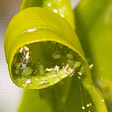 Aphid and their exoskeletons
Aphid and their exoskeletons 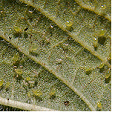 on underside of a leaf
on underside of a leaf
Black Citrus Aphid (Toxoptera aurantii) has a soft plump green body and the black coloured adults may or may not be winged. They feed in groups, curling leaves and producing honeydew attracting sooty mould.
Green Peach Aphid (Myzus persicae) is a soft plump green insect up to 0.2mm long and may be wingless. The nymphs are yellowish green and are responsible for spreading viruses in Dianthus species.
Spruce Gall Aphid (Chermes abietis) form cone shaped galls up to 12mm long resulting from the feeding. The wingless female adult lays eggs on the stems and the immature females overwinter on bud scales. Large infestation will weaken trees such as Picea abies and Pseudotsuga menziesii.
Tulip Bulb Aphid (Anuraphis tulipae) is small, waxy grey coloured and infests the underside of the bulb scales or rhizomes. They occur in the ground or on above ground parts and during storage.
Life Cycle
These insects have a Hemimetabolous life cycle, i.e. The nymphs resemble the adults.
During spring all eggs produced hatch as female nymphs. Adult Aphids are capable reproducing without fertilisation. The males are only produced in some species as the weather cools down, and the day length shortens.
Aphids are capable of giving birth to living young and large populations build up quickly during summer. Over crowding causes the aphids to become smaller, less fertile and produce more winged forms that can migrate to other host plants.
There are many different types of aphids and the life cycle varies from warm to cold climates.
Typical life cycles
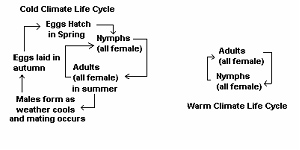
Distribution of the Pest
World wide
Period of Activity
In warm climates they are seen throughout the year, but aphids dislike hot dry or cold conditions and heavy rain will decrease the population. In cold areas aphid eggs are laid around a bud base or other protected areas of the plant during autumn and emerge as nymphs during spring, feeding on the new growth.
Numbers build up quickly in the warmer months of the year. Some species feed during winter on Sow thistles.
Susceptible Plants
There is a wide range of plants attacked, from roses to vegetables, shrubs and trees. Certain aphids attack a specific genus while others have a wide range of host plants. Many are capable of transmitting plant virus diseases.
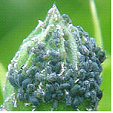 Adults and nymphs feeding
Adults and nymphs feeding 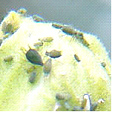 A colony of aphids
A colony of aphids
Acer species are attacked by several aphids including the Norway Maple Aphid (Periphyllus lyropictus) which is a greenish with brown markings and secret honeydew, preferring Acer platanoides. Other aphids include (Drepanaphis acerifolia) and (Periphyllus aceris) which are commonly found on the underside of leaves.
Acer species are also attacked by the Woolly Maple Aphid (Phenacoccus acericola) which covers the undersides of the leaves with a cotton-like mass
Alnus species are infested with the Alder Blight Aphid (Prociphilus tessellates) which is blue-black adult that forms woolly masses on the down-turned leaves. The nymphs overwinter in bark crevices.
Aquilegia species are attacked by several aphids including (Pergandeidia trirhoda) which is a small, flat cream coloured insect that is found on young branches and the underside of leaves.
Betula species may be attacked by the European Birch Aphid (Euceraphis betulae) which is small and yellowish or the Common Birch Aphid (Calaphis betulaecolens) which is large and green producing ample honeydew for sooty mold to grow on.
Callistephus species may be attacked by the Corn Root Aphid (Anuraphis maidi-radicis) causing the plant to become stunted, the leaves wilt and turn yellow. The aphids feed on the roots producing honeydew and are dispersed to other host by ants. It is also attacked by the Potato Aphid (Macrosiphum solanifolii).
Carya species are attacked by Gall Aphids (Phylloxera caryaecaulis) which is found on the leaves, twigs and stems forming galls and turning them black.
Chaenomeles and Gladiolus species, new growth and leaves become infested with the aphid (Aphis Gossypii)
Cupressus macrocarpa may become infested with the Cypress Aphid (Siphonartrophia cupressi).
Cyclamen species are attacked by the aphid (Myzus circumflexus) and (Aphis gossypii) which can infest healthy plants.
Dendranthema, Dianthus and Crocus species are attacked by several types of aphid including the Green Peach Aphid (Myzus persicae) and the Chrysanthemum Aphid (Macrosiphoniella sanborni).
Hibiscus species are attacked by the aphids (Aphis craccivora) and (Aphis gossypii), both congregate towards the branch tips and may cause leaf curl. Normally only seen in sub-tropical climates.
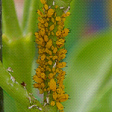 Aphids on a stem
Aphids on a stem 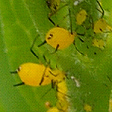 Mandevilla species
Mandevilla species
Larix species is attacked by the Woolly Larch Aphid (Adelges strobilobius). The winged adults deposit eggs at the base of the needles during spring and white woolly areas appear attached to the needles where the adult aphids feed. The young aphids overwinter in the crevices of the bark.
Mandevilla species is attacked by aphids that congregate towards the branch tips and may cause leaf curl.
Pinus species is attacked by several species of aphid including Pine Bark Aphid (Pineus strobi), Pine leaf Aphid (Pineus pinifoliae) and the White Pine Aphid (Cinara strobi).
Primula species are attacked by four species of aphid including foxglove, and green peach aphid.
Rudbeckia, Delphinium, Chrysanthemum and Helianthus species are attacked by a bright red aphid (Macrosiphum rudbeckiae).
Sorbus aucuparia is affected by the Rosy Apple and Woolly Apple aphid which attacked the foliage and young shoots.
Spiraea species are attacked by the Aphid (Aphis spiraecola) which feeds on the young shoots and flowers.
Tropaeolum species are attacked by the Black Bean Aphid (Aphis fabae), which is found in large numbers on the underside of the leaves, turning them yellow and causing them to wilt then die.
Tulipa, Iris, Freesia, Gladiolus and Zephyranthes species are infested with the Tulip Bulb Aphid.
Ulmus species are infected by two types the Woolly Apple Aphid (Eriosoma lanigerum), which curls and kills young terminal leaves and the Elm Leaf-Curl Aphid (Eriosoma ulmi) which occasionally attacks the trees.
Viburnum species are attacked by the Snowball Aphid (Anuraphis viburnicola). This aphid congregates at the end of the branches causing the leaves to curl and become deformed under which they hide.
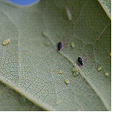 Aphids on Quercus robur
Aphids on Quercus robur
Damage Caused
Buds that have been attacked may not open, leaves and twigs become twisted or distorted and wilt. The aphids also produce honeydew, which is sticky and attracts sooty mould (fungus). This fungus forms a thick layer over the leaf, fruit or stems reducing the plants photosynthesis capability. The sooty mould spoils the plants appearance and its fruit, as does the insects white exoskeletons.
Control
Cultural Control
Aphids may be removed from a plant by hosing them off with water (limited success) or applying soapy water to aphids.. Another organic sprays can be efficient in controlling aphids. Aphids may also be removed physically by hand for small colonies on spine less plants. Species that live under ground are difficult to control but cultivation of the surrounding soil may help in controlling the infestation. (limited mainly to annual or commercial crops)
Reflective mulch around the plants also reduces numbers by repelling the insect this material is available commercially. (Reflective mulches are mainly used in market gardens for avoiding the Green peach Aphids) Resistant rootstocks are available to avoid some root feeding aphid of commercial plants, e.g. Vines and fruit trees
Biological control
Aphids are attacked by several insects includes parasitic wasps or predators such as ladybirds/ lady beetles, hover flies, lacewings, spiders.
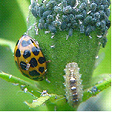
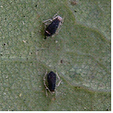 Parasitised aphids
Parasitised aphids
Chemical Control
Aphids may be controlled by spraying with a contact or systemic insecticide. The type of application used will depend on the plant is being attacked.
Aphids can be suffocated and therefore controlled with the use of e.g. White oil, Pest oil, Soapy water from soap such as Lux Flakes ®
Note
It is your responsibility by law to read & follow the directions on the label of any pesticide
Monitoring
Aphid are attracted by yellow colour and traps such as boards painted yellow and covered in glue or sticky substance will attract and trap the insects. There is also a commercially sticky yellow tape that can be attached to susceptible plants
Amendments by B. Sonsie Dip Hort Sc Burnley
PEST
NAME
Slugs and Snails
Various Snails Species
Description of the Pest
Slugs and snails are land molluscs. Snails produce an external spiral shell; slugs do not. The common garden snail Helix asperasa, grows up to 25 mm, long. Its body is slimy, broad, elongated and greyish, with two pairs of reticulated tentacles, with eyes at the ends of the longer pair. The mouth parts of snails and slugs contain a file-like organ known as the radula, which is used to rasp away at the host plant's tissue. Movement of the animal is by a muscular sliding movement, along a slippery trail of mucous; this solidifies on exposure to the air (typically described as a "silvery trail").
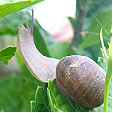
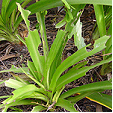
Appearance and Distribution of the Pest
Slugs and snails occur world-wide. Slugs tend to be more prevalent in heavier soil types.
Life Cycle
These insects have a Hemimetabolous life cycle, ie. When the immature nymphs resemble the adults.
Snail eggs are laid in moist soil, 20-40mm deep; eggs are white, spherical and appear in clusters of 30-100. Under favourable conditions, eggs hatch in 2-3 weeks. Newly emerged snails resemble tiny adults. When the weather is cold and dry, snails seal themselves into their shells where they survive, dormant, for 1-3 years.
Period of Activity
More active during the warmer months, although some species may remain active throughout the year.
Damage Caused
Native Australian slugs and snails are not commercial pests. Introduced species chew holes in foliage or skeletonise leaves; some plants may be completely defoliated plants; tubers and seedlings may be completely eaten. Slugs and snails feed mainly at night, especially after rain or watering; they shelter in cool, moist locations during the day. When the weather is dry, snails seal themselves into their shells with a mucous membrane, where they survive, dormant, for 1-3 years. Some species may consume up to one third of their body weight each day.
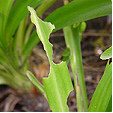

Susceptible Plants
A wide range of leafy plants, including ground crops, potatoes, tubers, leafy vegetables and seedlings.
Fern species are attacked causing serious damage. New fronds are repetitively eaten causing the plant to become stunted. Attacks are normally more severe during wet periods during which time control measures should be taken.
Morinda citrifolia is attacked by the Giant African Snail (Achatina fulica) which defoliates trees.

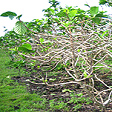
Cultural Control
Remove possible hiding places and avoid overhead watering to reduce humidity. Cultivate soil regularly; in commercial situations, allow the soil to remain fallow for one season to reduce numbers. Domestic infestations may be removed by hand. Traps may be created by inverting small pots near where snails and slugs are feeding; they will gather in these shelters during the day, and may be collected and destroyed. The popular Australian "beer trap" consists of a vertically-sided container, sunk into the ground and filled with beer, which intoxicates and drowns the snails.
Biological Control
Natural predators such as birds, frogs, and lizards reduce numbers, but do not provide effective control. Orchardists have used running ducks to control snails with some success.
Chemical Control
Commercial baits - molluscicides - made from methiocarb or metaldehyde are effective when used in combination with sanitation. Their effectiveness varies according to soil and weather conditions; it is generally recommended to avoid watering after application.
Note
Always read the label for registration details and direction of use prior to application of any chemicals.
PEST
NAME
Two-spotted Mite, Red Spider Mite
Tetranychus urticae
ORDER
Acarina
FAMILY
Tetranychidae
Description of the Pest
Also known as the red spider mite. Females are pale green or yellowish, depending on the host plant, and have two dark lateral markings; the mite becomes red in winter, retaining their dark markings. Nymphs are six-legged, with another pair of legs appearing as the mite matures. Males are smaller and narrower. Fully-grown adults are just visible to the naked eye. Two-spotted mites spread by crawling between nearby plants or movement of dead leaves.
Appearance and Distribution of the Pest
Found world-wide; an introduced pest in Australia. They congregate in protected places, such as under bark and at the base of trees, during winter. During spring, they become green in colour, and migrate back into the leaves. During heavy infestations, the leaves may be covered in visible webs, which they spin as they feed. Leaves may eventually wither and fall. Mites can spread via the movement of dead leaves, or in webs that have become attached to birds or large insects. They initially appear on the undersides of leaves.
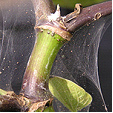
Spruce Spider Mite (Oligonychus ununguis) is a tiny greenish black adult which lays eggs on twigs where they overwinter. The pale green young spiders suck the sap turning the leaves yellow to brown. Heavy infestations form webbing and the pest is found on Abies and Juniperus species.
Banana spider mite (Tetranychus lambi) is a major widespread pest of bananas. It differs from two spotted mite by not producing copious amount of webbing. It is highly active during the dry spring to summer period and with the onset of the wet season mite numbers are reduced. The warm dry conditions that are created under plastic bunch covers is ideal for building up banana spider mite numbers.
Damage is normally confined to the underside of leaves appearing as rusty patches that coalesce along the leaf veins eventually turning the whole leaf brown-grey before it collapses. Fruit is damaged, close to the bunch stalk causing the area to become dull red purple-black, which in turn becomes dry then cracks.
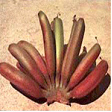 Damage fruit
Damage fruit
Control methods include careful water management during dry periods, and the reduction of dust from roadways. Regular desuckering and leaf trimming of plants will assist with a good coverage when spraying miticides.
Life Cycle
Mites have a gradual metamorphosis, with several nymphal stages. Each female lays up to 100 eggs that hatch in 7-14 days, with several generations appearing throughout the year. Females may become inactive during cold weather.
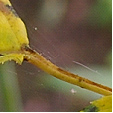 Webbing
Webbing 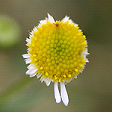
Period of Activity
The Two-spotted mite is most active in hot dry conditions. Under optimum conditions, the population can double every four days. It produces large quantities of webbing for over-wintering nests. Many plants are only susceptible to this insect when cultivated under glass.
Damage Caused
Adults and nymphs lacerated the undersides of the leaves with there rasping mouth parts, although infestations on both surfaces are not uncommon. Infestations cause leaf mottling leaf fall; premature leaf loss causes loss of vigour and reduces the quality and quantity of future crops. Repeated infestations, year after year, may weaken root growth and kill herbaceous plants.
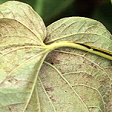
Susceptible Plants
A wide range of plants are attacked by the Red Spider Mite including annuals, fruit trees and vegetables, ornamental shrubs and trees.
Note
Many plant species are more susceptible to Red Spider Mite when they are cultivated under glass.
Other species of mite that are mentioned below have simular characteristics.
Calluna, Rose, Tropaeolum and Viola and species are infested with the Red Spider Mite (Tetranychus telarius) commonly in greenhouse situations.
Musa species are attacked by two spotted mite and banana spider mite damaging foliage and fruit.
Juglans species can be infested with up to four types of mites including red spider.
Cultural Control
Heavy rain or irrigation can reduce numbers; some plants may benefit from replanting in cooler locations. Generally, however, infested material should be completely removed and destroyed.
Preventative measures such as removing weeds or mulching around trees or shrubs or scrubbing the loose bark of susceptible trees during winter helps reduce numbers. During spring sticky bands can be wrapped around trunks close to the ground to trap the mites.
Biological Control
Natural predators include lacewings, ladybirds and thrips help keep the numbers down. Insecticide-resistant predatory mites (Typhlodromus occidenyalis) are also available commercially to control the Two-spotted Mite only on a large scale, as they require ample mites to survive.
Chemical Control
Spraying should be carried out as a last resort as many predators are killed during the operation and spraying can have the opposite effect by increasing numbers in the long term. Dimethoate will reduce numbers; however, Two-spotted mites are resistant to insecticides in some areas. Dusting with wettable sulphur may also prove effective.
Note
Always read the label for registration details and direction of use prior to application of any chemicals.
PEST
NAME
Fuller's Rose Weevil
Various Rose Weevil
Species
ORDER
Coleoptera
Description of the Pest
The Fuller's Rose Weevil (Asynychus cervinus) is greyish-brown and grows to 7mm long and is found in Australia. The female adult has faint white marks on its sides and feeds on leaf margins and flower buds. It lays its eggs under loose bark or in curled dead leaves that have fallen to the ground. The light grey lava is up to 6mm long burrow down feeding on the roots, where they overwinter.
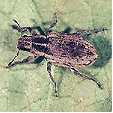
The Fuller's Rose Weevil (Pantomorus godmani) female adult is greyish-brown, up to 8mm long with diagonal white stripes across its wing covers and feeds on leaves at night. It is found in northern and southern USA. The lava feed on the roots and overwinters under ground.
Distribution of the Pest
Fuller's Rose Weevil's are found throughout the world and are distributed by walking to a new host or are transported on infested plants.
Life Cycle
These insects have a Holometabolous life cycle, ie. When metamorphosis is observed during the pupal stage.
The adult female can live up to three months during which it can lay up to ten groups of thirty eggs and the lava, can remain under ground for up to nine months before emerging as adults.
Period of Activity
The adult is most active from summer to autumn.
Damage Caused
Generally the adults chew leaves, preferring new foliage or flower buds and on mass can cause sever damage to the host. The roots are attacked by the lava and may cause yellowing of the foliage and small plants such as Lycopersicon species may be killed.
Susceptible Plants
There are many plants that are attacked by these pests, particularly broad leafed types.
Camellia, Citrus, Dahlia, Gardenia, Passiflora, Prunus, Rosa and Rubus species are susceptible to the Fuller's Rose Weevil (Asynychus cervinus).
Acacia, Begonia, Camellia, Canna, Chrysanthemum, Cissus, Citrus, Dianthus, Diospyros, Dracaena, Fuchsia, Gardenia, Hibiscus, Lilium, Pelargonium, Penstimon, Plumbago, Prunus persica, Quercus, Rhododendron, Rosa and Vinca, species.
All are susceptible to attack by the Fuller's Rose Weevil (Pantomorus godmani).
Cultural Control
Small infestations may be removed by hand at the adult stage and fallen leaves or debris should be removed from around the base of the plant. Sticky traps at the base of the plant may inhibit the adult climbing the plant.
Chemical Control
Plants may be sprayed with Carbaryl when the adults are first seen.
Note
Always read the label for registration details and direction of use prior to application of any chemicals.
PEST
NAME
Cutworms
Agrotis species
ORDER
Lepidoptera
FAMILY
Noctuidae
Description of the Pest
Cut worm larvae live in the soil, congregating in weedy areas; they chew off young seedlings at the base. They are smooth, thick fleshy grubs that vary in colour, from pinkish brown to olive green, or almost black. They grow up to 40mm long and 5mm thick. Larvae curl up when disturbed, pretending to be dead. Larvae burrow down into the soil to a depth of about 50mm to pupate. Adults are dark brown, hairy moths, with a wingspan of about 60mm.
These insects have a Holometabolous life cycle, ie. When metamorphosis is observed during the pupal stage.
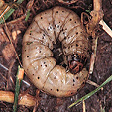
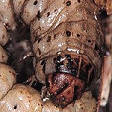
Appearance of the Pest
Adult moths are strong fliers capable of flying many kilometres laying eggs over a wide area. The eggs may remain dormant for several weeks until it rains or emerge within a few days under the right weather conditions.
Three similar species are commonly found in Australia:
· Agrotis ifusa (Bogong moth) is up to 50mm across and has three spots on its forewing.
· Agrotis munda (pink cut worm); and
· Agrotis ipsilon (black cut worm).
 Agrotis munda
Agrotis munda
Period of Activity
Different species are active throughout the year, their prevalence being determined by rainfall and temperature. They are normally most active at night. Larvae will appear in greatest numbers when favourable environmental conditions produce lush growth.
Susceptible Plants
Cutworms prefer soft, succulent seedlings or fleshy annuals, perennials and a variety for ferns or orchids. They feed at night and remain in the soil during the day. They are most commonly found in soil that is infested with weeds or soil that is poorly drained and moist. Well-drained soils harbour less lava.
Senecio and Dianthus species are attacked by the Cutworm (Peridroma margaritosa) which eats seedlings, leaves and flower buds. Under glasshouse conditions all stages of the lifecycle are present.
Turf Grasses are attacked by several Agrotis species causing damage during different seasons according to there individual life cycle. All feed at night on the leaves when young and mature larvae shear plants stems at ground level.
Damage Caused
Young larvae feed on the lower epidermis of leaves. Adults attack stems and seedlings at the base, eating the soft new growth, on one side, or completely through. The damaged plant normally topples over (hence the common name). Mature plants may wilt or the foliage becomes yellowish as a result of the damage, but normally recovers.
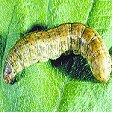
Cultural Control
Weed removal and cultivation to improve the drainage of the soil will provide some reduction in of numbers. Seedlings may be protected by a physical barrier, (eg plastic tube pushed into the soil around the seedling). Heavily infected soil can be laid fallow with for several weeks to disrupt the life cycle or the soil can be covered in black or clear plastic until weeds and lava are dead.
A molasses based bait that has hardwood sawdust and bran mixed with water creates a stick mass that the lava is attracted to but cannot escape. At sunrise they die from dehydration.
Biological Control
Natural predators such as birds, ground beetles and certain bugs help keep numbers down. Wasps and certain species of flies also attack the lava.
Encouraging earthworms by mulching and increasing the humus level is an excellent way to rid the soil of lava.
Chemical Control
Chemical treatment (Carbaryl) may be effective if sprayed in the evening, when the caterpillars emerge to feed.
Note
Always read the label for registration details and direction of use prior to application of any chemicals.
DISEASE
NAME
Rust (General)
Various Rust Species
Description
Generally this fungal problem involves many species causing a range of symptoms, but generally produces pustules that release reddish - brown spores. Most fungus is specific to its host and normally will not infect other plant species.
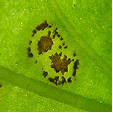 Pustules
Pustules
Symptoms
The upper leaf surface develops red, brown or yellow areas and the underside produces bright yellow to orange spores that correspond to the patches above. Infested leaves become brown in patches, fall prematurely and flower and fruit may also be infected. This overall, results in a loss of vigour and in small plants may lead to death.
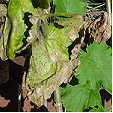 Pelargonium x hortorum
Pelargonium x hortorum
Myrtle Rust (Puccinia psidii) This fungal disease infects plants in the Myrtaceae family and was only recently detected in 2010 and has since spread across eastern Australia from the Northern Territory to Queensland, NSW, Victoria and Tasmania. This rust attacks soft and actively growing foliage or shoots with varying symptoms. It normally starts as small purple spots on the leaves from which spores form in yellow pustules that fade to grey as the infection matures and can merge creating leaf distortion and death of the plant.
The life cycle starts when the powdery yellow spores are distributed by wind to other plants where they germinate and start to grow by piercing the plant cells to obtain nutrients. Germination occurs in dark moist positions with a temperature between 15° to 25°C and the new pustules can release spores in 10 to 12 days, (spores remain viable for 3-months). The spores spread rapidly by wind, water, insects or animals. They are also distributed by plant material, clothing, shoes and vehicles.
 Puccinia psidii
Puccinia psidii
Needle Rust (Melampsora farlowii) infects the new leaves turning them to yellow and fall from the shoot giving the branch a scorched appearance. The fruiting bodies are found on the underside of the leaf and is waxy-red.
Rust in Poplar (Melampsora species). A fungal problem involving at least two species (Melampsora medusae) and (Melampsora larici-idaei).
The upper leaf surface becomes flecked with yellow to light green and the underside produces bright yellow orange spores that correspond to the patches above. Infested leaves become brown in patches, fall prematurely and shoots may die back as a result of not being hardened off to the elements. This overall, results in a loss of vigour and in small plants may lead to death.
The source of the fungus is from other infected plants or fallen leaves and is dispersed by wind.
Host plants include Lombardy Poplars particularly Populus nigra 'Italica' and cottonwoods.
White Rust (Albugo candida) forms snow white pustules that contain colourless spores that turn yellow then brown and are found on the underside of leaves.
White Pine Blister Rust (WPBR) is caused by the fungus (Cronartium ribicola). It is a obligate parasite requiring a living host to survive. The life cycle requires two host species with part of it life on the Pinus species and the other part on Ribes species. First cankers or sores appear on the Pinus species realising spores that land on the Ribes species infecting it. The infection produces a different type of spore that land on the needles and growing branches of the Pinus species and eventually forming cankers. The spores are spread by wind and prefer cool moist conditions. Symptoms include brown spots on the needles and the appearance of dead branches in the crown. Cankers will also appear on the trunk and it tends to attack young trees. Control methods include removal of Ribus species in the affected areas and breading naturally resistant Pinus species.
The Rust (Endophyllum sempervivi) affects Sempervivum species by infecting the young leaves and eventually the crown. The mycelium then travels to the roots and extends into any off shots. Leaves that are infected turn yellowish, grow longer and are thin. Persistent infection may kill the plant.
Source and Dispersal
The source of the fungus is from other infected plants or fallen leaves that contain the fruiting bodies and is dispersed by wind.
Favoured Conditions
Generally rust is more prevalent during summer, preferring warm humid conditions and particularly when the leaves are damp.
Affected Plants
A wide range of ornamental annuals, perennials, ferns, trees, shrubs including, Hibiscus species that are infected by Kuehneola malvicola predominantly in southern USA.
Abies species are infected by many types of rust including (Milesia fructuosa) and (Uredinopsis mirabilis).
Abutilon, Phymosia and Alcea species are infected by the rust (Puccinia heterospora).
Alnus species are occasionally infected with Leaf Rust (Melampsoridium hiratsukanum) which forms yellowish pustules on the leaves that develop turning the leaf brown.
Amelanchler species and Calocedrus decurrens are infected by several rust species including (Gymnosporangium libocedri).
Antirrhinum majus (Snapdragon) is infected by the rust (Puccinia antirrhini). This fungal problem that infects the epidermal layer on the leaf underside, forming pale green areas that are raised and split open revealing reddish brown spores that have a dusty appearance.
As the infestation grows, concentric rings of spore pustules appear around the original infection. The corresponding position on the upper leafs surface turns yellow eventually causing the leaf to wilt and die. The infestation is not restricted to the leaves; all above ground parts of the plant are susceptible and infected plants transmit the fungus dispersing it by wind.
Infected plants should be removed and destroyed.
Anemone and Prunus species are infected by the rust (Tranzschelia pruni-spinosae) that stimulates abnormal growth in the plant during spring.
Aquilegia, Anemone, Delphinium and Clematis species are infected by the Rust (Puccinia rubigo-vera var. agropyri).
Arctostaphylos manzanita is infected by the rust (Pucciniastrum sparsum) occurring in coastal regions but is not normally detrimental to the plant.
Artemisia species are infected by the rust (Uromyces ari-triphylli) which is a systemic disease that is transmitted through seeds. It causes the leaves to turn yellow then die and can infect all parts of the plant except the roots.
Bambusa species are infected by the rust (Dasturella divina) which forms elongated brownish strips on the leaves.
Berberis species may be infected by the Rust (Puccinia graminis) that forms orange spotting on the leaves. It certain regions plants infected with this rust must be removed and destroyed to avoid infecting neighbouring agriculture crops.
Betula species may be infected by Leaf Rust (Melampsoridium betulinum) that forms reddish-yellow spots on the leaves and heavy infestation can defoliate the tree. The host tree changes to Pseudolarix species during the sexual stage and causes blistering of the leaves.
Calendula species may be infected by the Rust (Puccinia flaveriae).
Callistephus and Solidago species may be infected by the Rust (Coleosporium solidaginis) which forms bright yellow spots particularly on new foliage or young plants.
Canna species may be infected by the rust (Puccinia Thaliae).
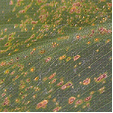
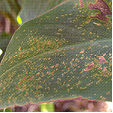 Canna indica
Canna indica
Centaurea species are infected by the rust (Puccinia cyani) and (Puccinia irrequisita) which can cover the stems and leaves.
Cleome species are infected by the rust (Puccinia aristidae) but rarely requires control.
Dianthus species are infected by the rust (Uromyces dianthi) which forms powdery brown spots that appear on both sides of the leaves. The leaves curl and die and the plant becomes stunted. This is a common problem that occurs when grown in a protected enclosure (hot house).
Ficus species are infected by the rust (Cerotelium fici) which forms small brown spots, and causes the leaves to turn yellow then fall prematurely.
Fuchsia species are infected with (Pucciniastrum epilobii). This fungus caused purplish red blotches on the upper leaf surface, that become dry in the middle and result in a brown patch with purple edges. On the underside of the leaf, corresponding to the patches, yellow orange spores form. Heavily infected leaves become yellow and drop prematurely. This leads to a loss of vigour in the plant and infected plants transmit the fungus.
Certain cultivars are more susceptible than others, particularly 'Orange Drops' and 'Novella'.
Hydrangea species is infected by (Pucciniastrum hydrangeae) causing yellowish brown pustules to appear on both sides of the leaf. The leaf becomes dry and brittle.
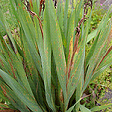
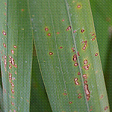 Iris species
Iris species
Iris and Dietes species are very susceptible to the rust (Puccinia iridis). Leaves form rusty red powdery spots that enlarge. They are appear on both sides of the leaves causing the surrounding area to turn pale yellow then brown and the black spores appear soon after, overwintering on dead infected leaves. Plants may be heavily infected but normally survive attack.
Larix species are infected by several Needle Rusts including (Melampsora paradoxa), (Melampsora medusae) and (Melampsoridium betulinum). The fungi attacks the needles predominantly towards the branch tips turning them yellow and eventually killing them . The underside of the leaf develops pale yellow fruiting bodies.
Lupinus species are infected by three species of rust including (Puccinia andropogonis var onobrychidis).
Malus andChaenomeles species may be infected by the rust (Gymnosporangium juniperi-virginianae) or (Gymnosporangium clavipes) which forms brown or bright orange spots on the leaves or twigs and can defoliate the tree. Juniperus virginiana and Mespilus germanica may also be infected by rust.
Mathiola and Arabis species are infected by White Rust.
Pinus species are infects by the Comandra Blister-rust (Cronartium comandre).
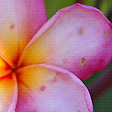
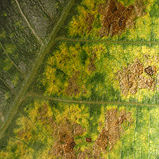
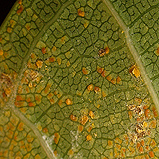
Plumeria rubra Leaf upper surface Leaf underside
Plumeria species are susceptible to the rust (Coleosporium plumeriae). Leaves and flowers may be infected with the underside forming bright yellow pustules and causes premature leaf or flower drop.
Populus nigra 'Italica' is infected by the rust (Melampsora species) which forms pustules to form on the leaves turning them brown and causing premature leaf drop.
Rhododendron and Tsuga species are infected by the rust (Pucciniastrum vaccinii) and is commonly found in nursery stock, spreading rapidly. Tsuga species are also infected by Needle Rust.
Ribes species are infected by the rust (Cronartium ribicola). This leaf rust appears on the underside of the leaves (preferably older leaves) forming dusty brown pustules and is a serious problem. This rust only appears when White Pine (Pinus strobes) grows near where the alternate stage of the fungus occurs.
Rudbeckia species are infected by several species of rust including (Puccinia dioicae) and (Uromyces rudbeckiae).
Salix species are infected by four types of (Melampsora species).
Senecio, Bellis and Calendula species are infected by the rust (Puccinia lagenophora) which forms blister-like pustules that release brown spores.
Sorbus aucuparia is affected by several rust from the (Gymnosporangium species) causing circular yellow spots, that appear on the leaves during summer and develop into orange cup-shaped fruiting bodies.
Trillium species are infected by the rust (Uromyces halstedii) that damages the leaf surface.
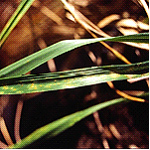 Festuca arundinacea
Festuca arundinacea 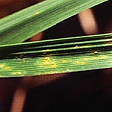 Rust
Rust
Turf Grass are susceptible to rust (Puccinia species) and (Uromyces species), causing yellow flecks to appear on the stems and leaves. These markings enlarge before the pustules form and in severs cases the lawn has a yellow, red or brown appearance.
The infection appears from spring to summer under humid low light conditions and turf that is under stress or with excessive nitrogen in the soil is more susceptible. Many species may be infected including Lolium perenne (Perennial Ryegrass) and Poa pratensis (Kentucky Bluegrass).
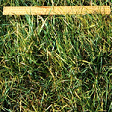
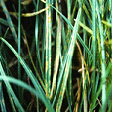 Rust on Perennial Ryegrass
Rust on Perennial Ryegrass
Viburnum species are mildly affected by two types of rust (Coleosporium viburni) and (Puccinia linkii).
Viola species are infected by the rust (Puccinia violae) which forms green spots on the underside of the leaves. It is not commonly seen on cultivated plants.
Non-chemical Control
Cut off and destroy any infected branches, fallen leaves and remove heavily infected plants. Improve the culture by, pruning to improve air circulation, allow space between plants and avoid over crowding. Avoid planting susceptible species. Plants that are infected with a systemic form should be removed and destroyed
Chemical Control
Not possible to spray large trees but young plants may be treated with a protectant fungicide such as wettable sulphur. In a domestic garden small plants such as Fuchsia species may be sprayed with a protectant chemicals as symptoms appear, aided by the removal of existing infected leaves. Under commercial conditions stock may be sprayed with a fungicide such as oxycarboxin.
Note
Always read the label for registration details and direction of use prior to application of any chemicals.
DISEASE
NAME
Fusarium Wilt (General)
Various Wilt Species
Description
Fusarium wilt is caused by specialised strains of the common soil fungus, Fusarium oxysporum.This fungus is microscopic, and that can live in the soil for many years and primarily attacks plants by entering through the roots. This affects corms, stems and leaves by moving through the water conductive tissue in the plant.
The specialised strains are known as formae speciales (f. sp. or special forms) and each f. sp. has a relatively narrow host range. For example Fusarium oxysporum f. sp. cubense causes Panama wilt of banana, F. oxysporum f.sp. vasinfectum infects cotton and F. oxysporum f. sp. lycopersici attacks tomatoes. Each strain is specific to that narrow host range and will not affect other hosts; this is important as it makes control options involving the planting of other plant species possible.
Symptoms
Generally the plant wilts quickly during hot weather or lacks growth and vigour. Typically the symptoms are often indistinguishable from drought stress. Leaves yellow and wither or stems split open near the base. Individual branches may collapse and die or entire plants perish. One of the distinctive symptoms is a one-sided yellowing and death of a leaf or branch. Corms become rotted with open wounds and affected stems, when split open are yellowish. There are variations in the symptoms depending on the type of plant but generally plants wilt, turn brown and die.
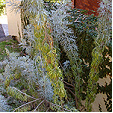
Basal Rot (Fusarium oxysporum) infects Tulipa and Crocus species by turning leaves reddish, which wilt and normally die. It also affects the bulbs by forming few roots and rotting the base, turning them dull white.
This disease also infects cactus such as Cereus species and Zygocactus truncatus causing soft black rot that appears at the tips of the plant then spread rapidly downwards. It is particularly virulent in hot beds, under glass. The infected plants cannot be cured and should be disposed off site.
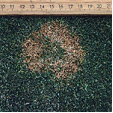 Fusarium Patch, Bent
Fusarium Patch, Bent  Fusarium Patch, Blue Grass
Fusarium Patch, Blue Grass
Other Fusarium (or related species) diseases
Fusarium Patch (Microdochium nivale formerly known as Fusarium nivale) is also known as Crown or Root Rot and infects warm or cool season Turf Grasses. The fungus infects the roots or rhizome turning them black, sometimes with a pink ting. During hot periods light green to brown patches appear in the turf as the damaged roots are unable to supply water to the leaves. This diseases is not a significant disease in Australia
Minimise irrigation of infected areas to reduce spread of infection as the spores are distributed in water.
Root Rot (Fusarium verticillioides) is a seed born fungus that infects Strelitzia reginae. It also forms a Leaf Spot in Dracaena species where rounded or irregular yellowish to reddish spots with a pail green border form. These are found on immature leaves and heavy infections may rot the crown.
Source and Dispersal
The fungal spores are dispersed by wind from infected plants or parts of plants. It is also dispersed by splashing water or contaminated stock or the movement of soil. With Fusarium wilt of canary island date palms the transfer of infected plant material on chain saws has been shown to be an important way in which the fungus can be transmitted from one tree to another. It is essential in these cases to sterilise the chain and chain bar between trimming the fronds on each tree.
Fusarium oxysporum produces three types of species, macroconidia, microconidia and chlamydospores. The latter two spore types play very important roles in the disease. The microconidia move in the vascular system of the plant and collect at the sieve plates in the xylem of plant. Here they germinate and grow and eventually block the sieve plate thus stopping the flow of water in the plant. The chlamydospores are specialised survival spores that persist in roots and in the soil for very long periods of time, thus allowing the fungus to survive periods when there are no susceptible plants present.
Favoured Conditions
The fungus prefers warm humid climates and is commonly seen in coastal regions and may continue living in soil for many years.
Affected Plants
Many species are infected including tomatoes, carnation, cucurbits and freesia. Die Back (Fusarium solani var. martii) causes damage to the branches of Ilex species. Fusarium also attacks palm species such as Phoenix causing wilt.
Albizia and Alternantera species are infected by the wilt (Fusarium oxysporum var. periciosum ) that causes the leaves to wilt, shrivel and die. This infection also extends to the branches and eventually may kill the tree.
Callistephus species are attacked by the wilt (Fusarium oxysporum f. sp. callistephi) which infects the vascular bundles turning brown, particularly on one side of the stem causing the plant to become stunted, eventually dieing.
Dendranthema and Thymus species are susceptible to the Stem Rot (Fusarium species) and (Pellicularia filamentosa) which rots the base of the stem.
Dianthus species are infected by Bud Drop (Fusarium poae). This fungus rots flower buds prior to opening and infected flowers open with distorted, unattractive petals. The control of thrips is essential. Dianthus species are also infected by Wilt (Fusarium oxysporum) that causes yellowing and wilting of the lower leaves, normally on one side. The infection causes stems to rot with vascular discolouration.
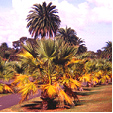
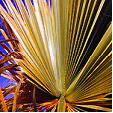 Fusarium Wilt Image by B. Sonsie
Fusarium Wilt Image by B. Sonsie
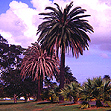
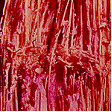 Image by Dr Brett Summerell
Image by Dr Brett Summerell
The only palms susceptible to Fusarium wilt are Phoenix species, especially Phoenix canariensis and juvenile Washingtonia filifera. Initially the leaflets turn yellowish then brown, on mature fronds causing them to die. Eventually only tufts of new growth remain the plant. As the infection continues the plant collapses and dies.
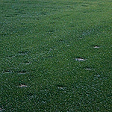 Fusarium Patch
Fusarium Patch
Turf grasses are infected by Fusarium Patch (Microdochium nivale). Plants include; Digitaria didactyla (Blue Couch), Cynodon species (Couch), Eremochioa ophiuroides (Centipede Grass), Festuca species, Paspalum vaginatum (Salt Water Couch), Pennisetum clandestinum (Kikuyu), Poa species (Bluegrass), Stenotaphrum secundatum (Buffalo) and Zoysia species. Generally the fungus produces small dead circular patches in the lawn.
Non-chemical Control
Fusarium diseases are extremely difficult diseases to control primarily because of a lack of a chemical control option and because the fungus is able to persist in soil for long periods of time. Crop rotation to non susceptible plants is advised and consequently it will be important to have the disease accurately diagnosed to ensure the identity of the pathogen and the possible rotation options.
Remove and destroy any infected plants. In the case of large trees or palms, it will be necessary to remove the infected plant, this not only means cutting down the above ground parts, but also removing the roots of the plant. These will then need to be removed and destroyed.
Fusarium Patch can be minimised by reducing thatch and aerating the soil regularly or improving the drainage.
Chemical Control
There are no effective chemical control options currently available for plant diseases caused by Fusarium species.
Note
Always read the label for registration details and direction of use prior to application of any chemicals.
Amendments by
Dr Brett Summerell
Director Science and Public Programs
Royal Botanic Gardens Trust, Sydney
DISEASE
NAME
Bacterial Rot
Various Bacterial Species
Description
Bacterial problem associated with water soaked strips on the leaves, stem, roots, fruit or flower. Bacterial wilts produce causative slime that clogs the water-conductive tissue of a plant.
Symptoms
Bacterial Blight (Pseudomonas mori) forms water soaked spots on the leaves and shoots, becoming sunken and turning black causing the leaves and twigs to wilt and die.
There is also a Bacterial Blight (Pseudomonas syringae pv pisi) that infects legumes during humid weather with water soaked spots on the leaves and stems near the base. The spots become dark and as the stem shrivels, yellow lesions appear. Leaves and fruit pods turn brown and die.
Bacterial Leaf Spot (Pseudomonas viburni) forms wet spots that enlarge becoming brown and sunken. These spots can be seen on the leaves and young stems and the bacteria overwinter in buds or in cankers. It is found on Viburnum species.
Bacterial Wilt (Xanthomonas species) infects palms causing the lower fronds to wilt then turn grey-brown and die. This is followed by the crown becoming spongy (rotted) attacking the vascular tissues and eventually causing the collapse of the crown. There is also a Bacterial Leaf Spot (Xanthomonas species) that causes spots on leaves with water-soaked margins and is found on Alocasia species.
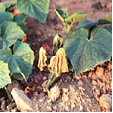 Bacterial Wilt
Bacterial Wilt
Bacterial Wilt (Pseudomonas solancearum biovar 1 and 3). This disease initially turns the youngest leaves pail-green to yellow; they then wilt turn brown and die. It eventually affects the entire plant and is found on Heliconia species.
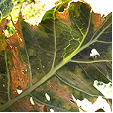
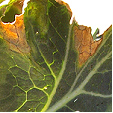 Black Rot or Bacterial Wilt
Black Rot or Bacterial Wilt
Black Rot or Bacterial Wilt (Xanthomonas campestris) is a bacteria rot that infects the leaves and seedlings of Cruciferous vegetables causing 'V' shaped pale yellow blotches to appear, normally infection occurs along the margin of the leaf or through damaged areas of the leaf. It also causes the flower head to become stunted and the veins or water conducting tubes in the leaves and stems to turn brown or blackish. Heavy infections cause the plant to wilt and die.
Bud Rot (Xanthomonas cannae) infects young leaves and flower buds of Canna species, killing them. Small whitish spots appear as the leaves or buds open, these enlarge then run together turning black. The symptoms also extend to the petioles and stems forming yellowish water soaked areas and the bacterium overwinters in the rhizomes.
Halo Blight of Beans (Pseudomonas syringae pv phaseolicola) forms water soaked or greasy angular spots on the pods or stems of the host. This causes the plants to yellow and become stunted. During humid weather a white slime is exuded from the damaged areas.
Soft Rot (Pecotbacterium carotovorum) affects bulbs, initially stops flowers from blooming or forming correctly. These flowers are shed, and the plant rots at the base causing it to collapse. On inspection of the bulbs a white foul smelling viscous smell is associated with a soft rot.
Wetwood (Erwinia nimipressuralis) causes wilting and branch dieback in Ulmus species. The wood forms dark water soaked areas with no obvious streaking in the outer sapwood.
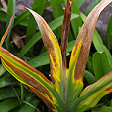 Yellow Rot in Iris
Yellow Rot in Iris
Yellow Rot (Xanthomonas hyacinthi) is a bacterial disease infects the cell walls of the leaf, stem and bulbs and caused yellowish water soaked areas to appear. These areas become brown and shrivel, or pockets of rot appear, soon engulfing the entire bulb. The disease may start from the leaf down or from the bulb up infecting the whole plant. A cross section reveals vascular tissue that is choked with yellowish slime. Infected plants soon brown off, collapse and die.
Source and Dispersal
The bacterium is found in infected plant material and not necessarily the soil and is spread by splashing water, wind or infected stock.
Favoured Conditions
It prefers warm moist conditions normally during spring.
Affected Plants
These bacteria attack many plants including; onions, Hyacinth species and its varieties, this can be a major problem in bulb nurseries.
Vegetables such as potatoes are also infected by blight which forms dark brownish spots on the leaves that become larger, eventually killing them and followed by lesions on the stems. The roots are infected by falling spores and peas suffer from a bacterial blight that forms spongy leaves with dark brown edges. The leaves and stem shrivel and die.
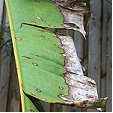 Strelitzia nicolai
Strelitzia nicolai
Archontophoenix and Strelitzia species are susceptible to the Bacterial Wilt (Pseudomonas solanacearum). The leaves become yellowish and brownish along the margins causes the fronds to wilt and dry out. The vascular tissue in the stems then becomes blackish and the plant dies prematurely.
Berberis species are infected by the Bacterial Leaf Spot (Pseudomonas berberidis) forming irregular dark green water soaked areas that turn purplish brown. It also infects young shoots and petioles or damaged areas.
Bougainvillea and Limonium species are infected by the Bacterial Leaf Spot (Pseudomonas andropogonis) which forms orange angular spots that are lighter in the centre and cause the leaves to fall prematurely. It is most common in tropical regions.
Caryota mitis (Clumping Fish Tail Palm) is infected by the Bacterial Blight (Pseudomonas avenea). The symptoms include water soaked translucent areas along the leaf veins that mature to brown then black with a chlorotic halo that is up to 2 mm wide by 50 mm long. Leaves of all ages are infected and immature leaves are more severely infected.
Control methods include eliminating overhead watering, removing infected foliage and improve air circulation around the plant.
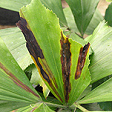 Caryota mitis
Caryota mitis
Cheiranthus species and other plants in the Brassicaceae family are infected by the Bacterial Wilt (Xanthomonas campertris) causing the leaves to wilt, turn yellow and die. It also stunts the inflorescence and turns the phloem and xylem blackish. Other plants that are infected include, Arabis, Armoracia, Aubrieta, Brassica, Hesperis, Iberis, Lobularia and Mathiola species.
Corylus species are infected by Blight ((Xanthomonas corylina) that attacks the leaves and branches.
Delphinium species are infected by several leaf spots including the bacterial disease Black Leaf Spot (Pseudomonas delphinii) which produces irregular tar-like spots on the upper surface of the leaf with corresponding brownish areas on the underside. This infection may extent down the petiole to the twigs. It normally occurs during cool weather affecting the lower leaves first.
Dianthus species are infected by the Bacterial Wilt (Pseudomonas caryophylli) which turns the leaves greyish, then yellowish before dieing. Yellowish streaks are also seen on the stems.
Dieffenbachia species are infected by two Bacterial Leaf Spots (Erwinia species) and (Xanthomonas campestris pv. dieffenbachiae). Both form yellowish spots that turn brown on the leaves that have water-soaked margins.
Eschscholtzia species are infected bt the Bacterial Blight (Xanthomonas papavericola) which forms tiny black spots that are water soaked and may be ringed.
Euphorbia pulcherrima is infected by Bacterial Canker (Corynebacterium poinsettiae) which forms streaks on the green stems that are water-soaked. The leaves may also be affected producing spots or blotches.
Gladiolus, Crocus and Freesia species are susceptible to Bacterial Scab (Pseudomonas marginata). This disease attacks the corms by forming slightly raised yellowish lesions that develops a raised rim with a soft sunken centre, producing bacterial exudate. It also infects the leaves with small reddish spots appearing towards the lower part. These spots merge and destroy the basic cell structure (parenchyma tissue) in the petioles causing the leaves to fold downwards, eventually killing the plant.
Hedera helix is susceptible to the Bacterial Leaf Spot or Stem Canker (Xanthomonas hederae). This infection commences with pale green water soaked spots or areas appearing on the leaves. These areas than become brown-black and dry with reddish margins, eventually engulfing the leaf causing it to shrivel. The bacterium then extends along the twigs and into the stems causing cankers. Several Fungal leaf spots develop simular symptoms and may be difficult to distinguish the difference. Generally avoid high humid temperatures and water plants at the base.
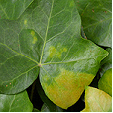
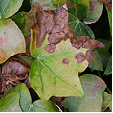
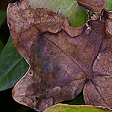 Hedera helix
Hedera helix
Morus species are infected by Bacterial Blight (Pseudomonas mori).
Orchids such as Cattleya, Cymbidium, Cypripedium, Dendrobium, Epidendrum, Oncidium, Paphiopedilum, Phalaenopsis and Zygopetalum species are infected by Bacterial Brown Rot (Pseudomonas cattleya) which forms water-soaked leaf spots that turn brown. Phalaenopsis species are particularly susceptible.
Caryota species are susceptible to Bacterial Leaf Blight (Pseudomonas albopercipitans). This disease forms elongated water soaked areas on the fronds that are translucent at first becoming blackish.
Roystonea regia, Cocos nucifera and Phaseolus species are infected by Bacterial Wilt (Xanthomonas species).
Tropaeolum species are infected by Bacterial Leaf Spot (Pseudomonas aptata) forming spots and rotting the leaves. They are also infected by the Bacterial Wilt (Pseudomonas solanacearum) which gains access through damaged roots or through the stomates, causing yellowing, wilting and the death of the plant.
Zinnia species are attacked by Bacterial Wilt (Pseudomonas solanacearum).
Non-chemical Control
Remove and destroy any infected plants. As a preventive measure cultivate the surrounding soil to improve drainage, aeration and minimise weed growth. Do not over water and allow the soil surface to dry before rewatering. When handling the plants pick a dry period and take care to minimise damage.
At first sigh of infection the plant should be removed and disposed off and avoid replanting susceptible vegetables such as peas for up to three years.
Chemical Control
There is no satisfactory chemical control. It is important to take preventive measures.
Note
Always read the label for registration details and direction of use prior to application of any chemicals.
DISEASE
NAME
Fasciation
A Mutation
Description
Non-pathogenic
Symptoms
Stems become enlarged and flattened and are normally associated with bunches of smaller leaves at the top of the affected areas.
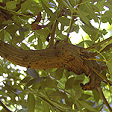
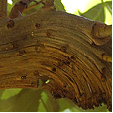 Fraxinus augustifolia
Fraxinus augustifolia
Source and Dispersal
This is a genetic mutation and little is known of its source or its dispersal.
Favoured Conditions
It is unknown what conditions are favourable.
Affected Plants
Many ornamental plants are affected these include, Senna, Allocasuarina, Cottoneaster and Daphne, and Rosa species. Actinotus helianthi may also be infected.
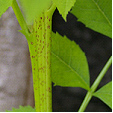
Trees such as Fraxinus augustifolia are also affected causing deformities in branches or stems.
Non-chemical Control
Prune off affected parts.
Chemical Control
Not applicable
DISEASE
NAME
Crown Gall
Agrobacterium and other species
Description
Bacterial problem that is associated with wounds, caused by insects or physical damage in plant tissues.
Symptoms
Soft galls appear on the roots, base and up the stem becoming hard with age. The plant responds by loosing vigour and may produce less flowers or fruit.
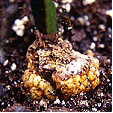
Source and Dispersal
The spores are found in the soil or are released from decaying galls and are spread by infested soil or plant material and contaminated tools.
Favoured Conditions
Continuous cultivation of infested plants allowing a build up of spores in the soil and poor propagation methods during grafting or handling transmits the disease.
Affected Plants
There are many species of woody plants that are affected these include, species in the Rosaceae family, Dahlias, Geraniums, Vitis and Brachychiton species.
Araucaria, Arbutus, Begonia, Chaenomeles, Corylus, Euonymus, Euphorbia, Leucanthemum, Protasparagus, Thunbergia and Wisteria species are infected by a simular crown-gall (Erwinia tumefaciens) which causes smooth swellings to appear on the roots and main stems of the host.
Large cactus species are attacked by the Crown Gall (Agrobacterium tumefaciens). It develops galls on segments and roots with some of the aerial galls attaining a diameter of over 600 mm. Root galls, become a spongy and may attain a diameter of 300 mm. Galls on aerial parts may be cut from the plant with some success. Control methods include not damaging the plant surface and any bacteria contaminated soil should not be used for propagation.
Sorbus aucuparia is seriously affected by this disease.
Non-chemical Control
Remove and destroy any infected plants and avoid replanting in the same area with susceptible species. Care should also be taken when selecting new plants that they are not infected, look for lumps at the base of the plant. Disinfect pruning or grafting tools to inhibit transmitting the disease.
A treatment of control is to dip seeds, cuttings and seedlings into a solution of a non-pathogenic strain of bacteria such as Agrobacterium rhizogenes before planting. This is commercially available under several brand names.
Chemical Control
There is no chemical control of this bacterial problem.
Note
Always read the label for registration details and direction of use prior to application of any chemicals.
DISEASE
NAME
Verticillium Wilt
Verticillium dahliae
Description
This is a soil based fungus that attacks the root hairs and travels throughout the plants vascular system.
Symptoms
With annuals or perennials such as dahlias lower leaves wilt, turn brown and die and the stems appear normal until the base splits open and turns blackish. This may extend throughout, killing the plant. With larger trees the fungus causes the leaves at the end of the branches wilt and die off.
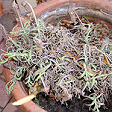
Verticillium albo-atrum is a soil born fungus that normally infects the roots acting on the water conducting cells by restricting flow causing the plant to wilt. On trees the leaves suddenly wilt and die. This may happen on individual branches on one side of the tree. Other symptoms are leaves form smaller than usual turning yellow and the plant may not shoot the following season. Trees may die over a short or long period of time depending on the severity or number of infections it has incurred and Acer saccharinum and Catalpa species are most susceptible.
Source and Dispersal
It is found in the soil and dispersed by movement of soil i.e. in containers or on machinery. The fungus may survive in the soil for many years.
Favoured Conditions
Moist poorly drained soils are prone to fungus and during the cooler humid months the fungus is most active.
Affected Plants
There is a wide range of hosts including tomatoes, potatoes, chrysanthemums and other perennials. It also found in shrubs and trees.
Acer, Achillea, Koelreuteria , Paeonia and Syringa species are infected by Verticillium albo-atrum causing wilting. Erythrina x sykesii may also become infected.
Berberis species are infected with Verticillium albo-atrum causing the leaves to turn brown, shrivel then die.
Non-chemical Control
Cultivate soil to improve drainage and aeration. Cut down and destroy any infected plant material and when taking cuttings from a susceptible plants quarantine them, to ensure they are not infected. Infected soil may be allowed to lay fallow for 2 to 3 years and when replanting used resistant plant varieties.
Chemical Control
For quick control of a cultivated area the soil will require treatment with a fungicide. Consultation with your local Department of Agriculture is advised.
Note
Always read the label for registration details and direction of use prior to application of any chemicals.
DISEASE
NAME
Leaf Spot (General)
Various Leaf Spot Species
Description
There is a wide variety of fungal leaf spots that infect perennials, shrub and trees. Some are specific to the host while others can affect a range of plants.
Symptoms
Generally light brown to purplish or blackish spots appear on the leaf and form concentric rings of fruiting bodies. The spots may leave holes, perforating the leaf or expand with pale green to yellowish margins and when the holes merge the leaf normally dies. There are many different types of leaf spot, some are discussed below.
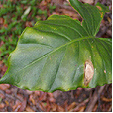 Alocasia species
Alocasia species 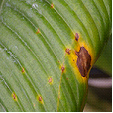
Alternaria Leaf Spot (Alternaria nelumbii) forms a small reddish brown spots that are boarded in light green, and as they develop in size the leaf curls and dies from the margin inwards. Normally occurs on Nelumbo species (water lilies).
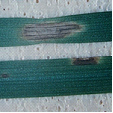 Helminthosporium Disease
Helminthosporium Disease
Helminthosporium Disease (Bipolris species), (Drechslera species) and (Exserophilum species) are responsible for several leaf spots that occur on all Turf Grass species. Generally they form black or white spots that may be faded and produce masses of spores in the thatch during late summer, under humid conditions. The life cycle is short and when conditions are favourable spores are splashed onto the foliage from the thatch, causing wide spread infection. Cynodon dactylon (common couch) is most susceptible and found in bowling or golf greens where it is a serious problem.
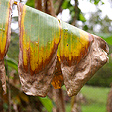 Banana Leaf Spot
Banana Leaf Spot 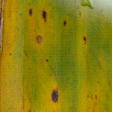
Banana Leaf Spot (Mycosphaerella musicola) is found on many species of banana causing pale yellow streaks on the young leaves to turn brown with dark spots. The leaf then becomes dried, brown and dead commencing from the margins, eventually the leaf dies. Control requires removal of infected foliage or the spraying of a fungicide and fungicides should not be used during the fruiting period.

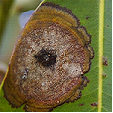 Lophostemon confertus (Brush Box)
Lophostemon confertus (Brush Box)
Leaf Spot on Brush Box (Elsinoe species). This is a casual fungus that attacks the epidermal layer of the leaf, forming circular spots that are up to 25mm across and are often restricted by the main vein. These spots are a dull yellowish brown but can also have purplish patterns. A leaf may have more than one spot develop on its surface and normally appears on scattered leaves throughout the tree. This doesn't affect the vigour of Lophostemon confertus.
Palm Leaf-scab (Graphiola phoeicis) appears as yellow spots and develop into scabs or warts that are outwards hard and dark but with a soft centre with powdery yellowish brown spores. The infected leaves eventually die.
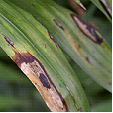 Palm Leaf Spot, Chamaedorea elegans
Palm Leaf Spot, Chamaedorea elegans
Palm Leaf Spot (Pestaloptiopsis species) appears as a small spot with a dark centre on the leaves and affects palms that are growing in shaded humid positions and normally control is not required, though infected fronds should be removed.
Source and Dispersal
Infection source is other contaminated plants and the spores are spread by wind or by splashing water. The fruiting bodies are black spots that appear on the damaged tissue releasing spores.
Favoured Conditions
This fungus prefers a warm humid environment and leafy plants with soft new growth, particularly if they are crowded.
Affected Plants
There are many ornamental and native plants that are hosts to a wide range of fungal leaf spots. Some specific ones are listed below. Plants such as Cornus or Paeonia species are infected by a large variety of leaf spots, while other plants attract a specific leaf spot.
Generally a healthy plant can tolerate fungal leaf spot attack, though it may make the plant look unsightly. In trees and shrubs it is difficult to control and generally not necessary, but in perennials and annuals control may be necessary in order to save the plant.
Acalypha and Arctotis species are infected by up to three leaf spots including (Cercospora acalyphae) and (Ramularia acalyphae) that rarely require control.
Acer species are infected by Purple Eye (Phyllosticta minima) which forms spots with brownish centres and purplish margins causing the death of the leaves.
Acer species are also infected by Tar Spot (Rhytisma acerinum) which forms round black spots that have yellow margins. Not normally seen on cultivated trees, but seen in forests.
Adiantum, Asplenium, Blechnum, Cyathea, Davallia, Nephrolepis, Platycerium, Polypodium and Pteris species are infected by the leaf spot (Pseudocercopora species) which forms circular brown spots on the fronds and heavy infection can defoliate a plant.
Aesculus species are occasionally infected with the leaf spot (Septoria hippocastani) which forms small brown spots.
Agave species are susceptible to the leaf spot (Coniothyrium concentricum), which appear as greyish spots up to 20mm (1in) across with concentric rings and black fruiting bodies. Affected leaves are destroyed as the infection spreads.
Albizia julibrissin is susceptible to the fungal leaf spot (gloeosporium aletridis), which does not normally require control.
Amelanchler, Chaenomeles, Crataegus and Rhaphiolepis species Mespilus germanica are infected by the leaf spot (Fabraea maculata) which may cause considerable damage during wet periods.
Aquilegia species can be infected by three types of Leaf Spot including (Ascochyta aquilegiae), (Cercospora aquilegiae) and (Septoria aquilegiae), normally appearing during humid conditions forming spots on the leaves.
Arbutus species are infected by two leaf spots (Septoria Unedonis) which produces small brown spots on the leaves and (Elsinoe mattirolianum).
Arctostaphylos manzanita is infected by the leave spot (Cryptostictis arbuti) which damages leaves but is not normally detrimental to the shrub.
Aspidistra species are infected by the leaf spot (Colletotrichum omnivorum) causing whitish spots on the leaves and petiole.
Aster species are infected by many leaf spots including (Alternaria species), (Cercosporella cana), ( Ovularia asteris) and (Septoria asteris).
Aucuba species are infected by several leaf spots, usually as a secondary infection after aphid attack. These include (Phyllosticta aucubae) and (Phyllostica aucubae).
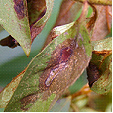
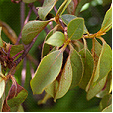 Azalea
Azalea
Azalea (Rhododendron species) are susceptible to Leaf Scorch (Septoria azalea). This fungal disease forms reddish- brown spots which expand and engulf the leaf, with fruiting bodies appearing in the centre. Infected leaves die, then fall and the branchlets wilt. This problem is more serious during wet periods and may require control using a fungicide.
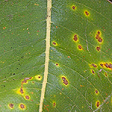 Banksia robur
Banksia robur
Banksia species are infected by several leaf spots causing chlorotic areas that have brown centres and is not normally a major problem for the plant.
Betula species may be infected by the Leaf Spots (Gloeosporium betularum) that forms brown spots with darker margins and (Cylindrosporium betulae) that also forms brown spots with faded indefinite margins.
Bougainvillea species are infected by the leaf spot (Cercosporidium bougainvilleae) which forms rounded spots with dark margins that yellowish ting. Infected leaves die and fall from the plant.
Calendula species are infected by the Leaf Spot (Cercospora calendulae) which rapidly infects the plant spotting the leaves and killing the plant.
Callicarpa species may be infected by the leaf spot (Atractilina callicarpae) forming irregular brownish spot or (Cercospora callicarpae) which can defoliate the plant in subtropical climates.
Campsis species may be infected by several fungal leaf spots including (Phyllosticta tecomae), (Septoria tecomae) and (Cercospora duplicata).
Carpinus species are infected by the leaf spots (Gloeosporium robergei), (Gnomoniella fimbriata) and (Septoria carpinea), all are minor infections not normally requiring control.
Carya species are infected by several leaf spots including (Gnomonia caryae) that infects leaves with irregular reddish spots on the upper surface with corresponding brown spore producing spots on the underside. It also has a secondary spore release that occurs on the dead leaves where it over winters. Other leaf spots include (monochaetia desmazierii) and (Marssonina juglandis).
Ceanothus species are susceptible to the leaf spot (Cercospora ceanothi) and (Phyllosticta ceanothi) both are of minor importance not requiring control.
Celtis species are infected by many leaf spots including (Cercosporella celtidis), (Cylindrosporium celtidis), (Phleospora celtidis) and (Septogloeum celtidis).
Chrysanthemums species are infected by the leaf spot (Septoria species) which forms yellow spots appear toward the edge of the leaves; these become enlarged brownish patches with yellow margins. Damaged areas may converge and in severe attacks and the leaves may fall prematurely or flower production is reduced.
Clematis species are infected by the fungal disease (Ascochyta clematidina) which may cause stem rot or leaf spots that are water soaked areas with reddish margins. The infection spreads from the leaves to the stem causing wilting and eventually girdling the stem killing the plant. There are many fungal leaf spots that infect this plant including (Cercospora rubigo) and (Septoria clematidis)
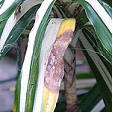 Dracaena deremensis
Dracaena deremensis
Cordyline and Dracaena species may be infected by the leaf spot (Phyllosticta maculicola) which forms small brownish spots that have yellowish margins and has black fruiting bodies that forms coils of spores. These plants are also susceptible to other leaf spots such as (Glomerella cincta) and (Phyllosticta dracaaaenae). Keep foliage dry to avoid infection.
Cynodon dactylon, Pennisetum clandestinum and many other Turf Grasses are susceptible to Helminthosporium Disease.
Daphne species are infected by the leaf spot (Gloeosporium mezerei) and (Marssonina daphnes) both of which form thickish brown spots that are seen on both sides of the leaves. Infected leaves turn yellowish before dieing.
Dendranthema species are infected by many leaf spots such as (Septoria chrysanthemi) which first forms yellowish spots up to 25mm (1in) across that become black. Infected leaves die prematurely and persist on the plant.
Dianthus species may be infected by the leaf spot (Septoria dianthi). It forms light brown rounded spots that have a purplish border. The scattered spots on the lower leaves can also be found on the stems and the spores are dispersed by water from the tiny black fruiting bodies.
Dieffenbachia species are infected by several leaf spot fungi including (Cephalosporium species) and (Myrothecium species).
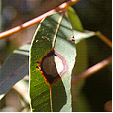 Eucalyptus species
Eucalyptus species
Eucalyptus species are infected by many fungal leaf spots such as (Mycosphaeralla species), (Hendersonia species) and (Monocheatia monochaeta). Generally leaf spots appear on the juvenile or new leaves causing brownish spots that enlarge and may have a purplish halo around the margin. Mature adult leaves are not normally infected and the trees rarely require control measures.
Fern species are infected by the leaf spot, (Alternaria polypodii). This fungus appears as brown circular or oblong spots that congregate along the margins of the pinnae causing the fronds to turn brown and die. It is spread by wind currents from plant to plant and control methods include removing infected fronds and maintaining a drier atmosphere.
Ficus species are infected by various fungal leaf spot including (Pseudocercospora species). Generally the fungal attack forms circular or irregular dark coloured spots on the leaves eventually causing them to fall prematurely.
Ficus elastica is susceptible to many fungal leaf spots including (Alternaria species), (Leptostromella elastica) and (Phyllosticta roberti).
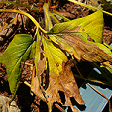
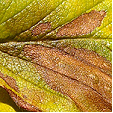 Strawberry
Strawberry
Fragaria x ananassa (Strawberry) is infected by the fungal leaf spot (Mycospharella fragariae). The mature leaf is initially infected with well defined brown spots that that turn light grey with red-purplish margins. As the spots merge they form large brown blotches and the leaf turns yellow then dies. This fungal attack normally occurs on plants in poor health and can be a serious problem early in the season seriously damaging stock.
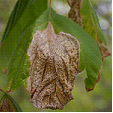 Fraxinus species
Fraxinus species
Fraxinus species are infected by the leaf spot (Gloeosporium aridum) giving the leaf a scorched appearance as large blotches appear from the margin or apex and turn brown with a papery texture. It is more prevalent during rainy periods and infected leaves fall prematurely. Collect and depose of fallen leaves otherwise control is not normally required.
Fuchsia species may be infected by the leaf spot (Septoria species) or ( Cercospora species), both form spots with dead centres and dark margins.
Gladiolus species are infected by Hard Rot or Leaf Spot (Septoria gladioli). On the corms reddish brown circular water soaked spots become large and sunken. These areas dry out and form obvious margins. The leaves may also have these symptoms but is not commonly seen.
Hemerocallis species are infected by several leaf spots including (Cercospora hemerocallis) and (Heterosporium iridis). These may be in the form of black spots or brownish spots that converge killing the leaf. Infected leaves should be removed and burnt.
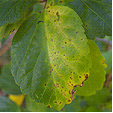 Hibiscus species
Hibiscus species
Hibiscus rosa-sinensis, Hibiscus syriacus and Hibiscus tiliaceus are susceptible to several fungal leaf spots including (Ascochyta abelmoschi), (Cerospora kellermanii) and (Phyllosticta hibiscina). All cause spotting or blotching of the leaf surface; remove and destroy infected parts.
Hydrangea species are infected by four fungal species including (Ascochyta hydrangeae), (Phyllosticta hydrangeae) and (Septoria hydrangeae).
Iris species are infected by several fungal leaf spots including (Alternaria iridicola) and (Macosphaerella species).
Iris species are also infected by the leaf spot (Didymellina macrospore) that forms greyish spots with brown water soaked borders and coalesce on the upper part of the leaf. This casual organism commonly occurs after flowering killing the leaves but will not infect the bulbs. The bulbs become weak over several seasons due to the decreased foliage.
There is also a Bacterial Leaf Spot (Bacterium tardicrescens) that is commonly mistaken as a fungal problem causing translucent spots that coalesce and involve the entire leaf. Normally found on Iris species.
Laburnum anagyroides is infected by the Leaf Spot (Phyllosticta cytisii). The leaf forms light grey spots with no definite margin and mature to brown. The black fruiting bodies appear as dots in the centre of the spot.
Leucanthemum species are infected by the leaf spot (Cerocspora chrysanthemi) and (Septoria leucanthemi).
Magnolia species are susceptible to many species including (Alternaria tenuis), (Mycosphaerella milleri) and (Phyllosticta species). Leaves generally turn brown from the apex or margins turning brown or spots appear on the leaf surface and leaves become yellow before withering and dieing. Normally the make the tree look poorly but have little effect on its growth. Control is not normally required.
Nerium oleander is susceptible to several fungal leaf spots including (Cercospora nerella), (Cercospora repens), (Gloesporium species) and (Phyllosticta nerii). Infected leaves should be removed but generally control is not required.
Nyssa sylvatica is infected by the leaf spot (Mycosphaerella nyssaecola) forming irregular purplish blotches.
Orchids such as Cattleya, Cymbidium, Cypripedium, Dendrobium, Epidendrum, Paphiopedilum, Phalaenopsis and Zygopetalum species are infected by several leaf spots including (Cerospora, Colletotrichum and Phyllosticta species). Normally forming dark or dead, circular or irregular areas on the leaves.
Palms such as Syagrus, Howea, Phoenix, Roystonea and Washingtonia species are infected by Leaf-scab (Graphiola phoeicis).
Palms such as Archontophoenix, Caryota, Chamaedorea, Cocos, Dypsis, Howea, Liculia, Linospadix, Livistona, Phoenix, Ptychosperma, Rhapis, Roystonea, Syagrus, Washingtonia and Wodyetia species are susceptible to several fungal leaf spots including;
(Bipolaris spp.), (Cylindrocladium spp.), (Colletotrichum spp.) and (Pestalotiopsis spp.).
Generally the circular leaf spots are brown and may have a yellow halo such as Palm Ring Spot (Bipolaris incurvata). They vary in size from small to large depending on the species. When a plant is healthy it recovers from attack, but heavy infections can defoliate, causing the collapse of the plant.
Palms are also infected by the Brachybasidium Leaf Spot (Brachybasidium pinangae). This fungus forms angular leaf lesions that produce fruiting bodies on the underside and is commonly found on Archontophoenix species.
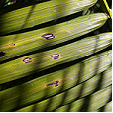
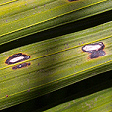 Archontophoenix cunninghamiana
Archontophoenix cunninghamiana
Passiflora species are infected with many types of leaf spot such as (Alternaria passiflorae).
Phoenix species are susceptible to False Smut (Graphiola phoenicis). This fungus forms yellow leaf spots that become hard with a raised with a blackish scab, which produces masses of powdery spores that are thread-like.
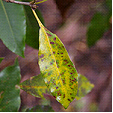
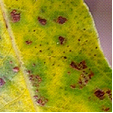 Pittosporum species
Pittosporum species
Pittosporum species are susceptible to the leaf spots (Alternaria tenuissima), (Phyllostica species) and (Cercospora pittospori). Circular or angular dark spots appear on the leaves and are surrounded by necrotic areas that are yellowish. Generally removal of infected leaves is adequate control.
Poa species and other cool season grasses are infected by Winter Fusarium Leaf Disease (Fusarium species), which causes small pale spots that are water soaked to appear on the leaves that turn red-brown. Infected leaves become bleached then wither and die, but the infection will not affect the crown or roots of the plant. It can be identified by pink, cotton-like mycelium and the plant prefers cold wet weather.
Populus species are infected by several fungal leaf spots including (Ciborinia bifrons, Ciborinia confundens), and (Mycosphaerella populicola).
Prunus species are infected by several leaf spots including (Cercospora circumscissa and Septoria ravenelii).
Pseudotsuga menziesii Douglas Fir is infected by the Leaf Cast (Rhabdocline pseudotsugae) Symptoms include the needles becoming yellowish at the apex and extending down the needle and spreading to others during moist spring weather turning them brown. Brownish scorched areas are noticeable on the tree from a distance. Control; is not normally required for mature trees but nursery stock may require spraying with a copper based fungicide.
Psidium guajava (Guava) is infected by (Glomerella cingulate). This fungus courses spots to appear on leaves and mummifies and blackens immature fruit or rots mature fruit. This fungus can devastate a guava crop.
Quercus species are infected by several types of leaf spot including (Cylindrosporium microspilum) and (Marssonina martini). These attacks tend top take place later in the season and normally not detrimental to the tree.
Rhododendron species are infected by a large variety of fungal leaf spots including (Cercospora rhododendri) and (lophodermium melaleucum)
Salix species are infected by several fungal leaf spots including (Ascochyta salicis) and (Septogloeum salicinum).
Senecio species are infected by the fungal leaf spot (Alternaria cinerariae) and (Cercospora species), forming dark rounded or angular spots.
Spiraea species are attacked by the fungal leaf spot (Cylindrosporium filipendulae).
Stenotaphrum secundatum (Buffalo) turf grass is susceptible to Grey Leaf Spot (Pyricularia grisea) in domestic and commercial situations devastating lawns. This fungal disease infects the stems and leaves with small brown lesions that enlarge rapidly forming grey-brown spots that have darker borders or surrounded by yellow chlorotic areas. This infection is commonly found on newly laid turf but will also infect established lawns. It is most prevalent during warm humid periods in soil with a high nitrogen level.
Syringa species are attacked by up to six species of leaf spot including (Cercospora lilacis) and (Phyllostica species).
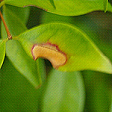 Syzygium species
Syzygium species
Syzygium species are infected by fungal leaf spots but normally control is not required.
Tagetes species are infected by the leaf spot (Septoria tageticola), which starts at the base and moves progressively up through the plant, covering the leaves in grey to black spots.
Trillium species are host to several leaf spots, including (Colletotrichum peckii) (Gloeosporium Trillii) (Heterosporium trillii).
Ulmus species are infected by many fungal leaf spots including (Gnomonia ulmea) and (Cercospora sphaeriaeformis).
Veronica species are infected by the leaf spot (Septoria veronicae). The symptoms include small violet to brown spots appear on the upper surface of the leaf and correspondingly yellowish brown on the underside. The spots converge forming a scorched shot-hole appearance and eventually death of the leaf.
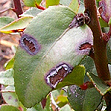 Vaccinium ovatum
Vaccinium ovatum
Vaccinium ovatum is infected by the leaf spot (Rhytisma vaccinii) and (Dothichiza caroliniana).
Vicia species are infected by the leaf spot (Erostrotheca multiformis), which forms greyish spots that enlarge and may defoliate the plant.
Wisteria species are infected by three fungal leaf spots (Phyllostica wisteriae), (Septoria wisteriae) and (Phomatospora wisteriae).
Non-chemical Control
Remove and destroy infected plant material and avoid overhead watering. When planting select infection resistant varieties. Practice crop rotation and add pot ash to the soil to decrease the plants venerability to the disease. Many species of fungus overwinter in fallen leaves, remove and destroy any litter under the plant.
Winter Fusarium Leaf Disease in Turf Grasses can be minimised by aerating the soil, reducing thatch and avoid excessive nitrogen in the soil.
Chemical Control
Protective fungicides such as zineb or copper oxychloride should be sprayed at the first sign of infection and cuttings should be sprayed as they start to grow.
Note
Always read the label for registration details and direction of use prior to application of any chemicals.
DISEASE
NAME
Mosaic Virus
Various species
Description
This is a casual viral organism that affects the leaves of the host.
Symptoms
Some of the host plant leaves becomes mottled towards the leaf margins, or completely yellow giving a variegated or marbled appearance. The leaves may also become distorted or crinkled. Flowers are also affected showing signs of colour breaking by forming patterns on the petals.
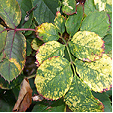
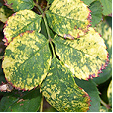 Rosa species
Rosa species
Rose Mosaic (Marmor rosae) causes intermittent irregular yellowish areas on the leaf surface of Rosa species. These chlorotic pattens tend to be along the mid rib but are also found along the margins.
Source and Dispersal
Propagation from infected plants will spread this disease. Certain species are also spread by insects such as thrips or aphids.
Favoured Conditions
There are no known favoured conditions but generally appears during the growing period.
Affected Plants
Many plants are infected by various Mosaic viruses such as Fragaria, species.
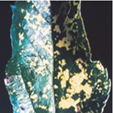 Apple Mosaic Virus
Apple Mosaic Virus
Camellia - particularly japonica and reticulata are infected by the Camellia Mosaic Virus. This virus is not thought to be transmitted by insects but through propagation methods such as grafting. The yellow mottled appearance on the leaves could also be attributed to genetic changes, as all affected leaves develop a simular pattern.
Delphinium, Limonium, Mathiola, Primula, Petunia and Cucumis species are infected by the Cucumber Mosaic Virus (Marmor cucumeris).
Laburnum anagyroides is infected by the Laburnum Vein Mosaic virus which causes vein banding on the leaves.
Orchids such as Cattleya, Cymbidium, Cypripedium, Dendrobium, Epidendrum, Oncidium, Paphiopedilum, Phalaenopsis and Zygopetalum species are infected by Cymbidium Mosaic Virus and Tobacco Mosaic. Cattleya and other orchid species exhibit leaf necrosis in the form of rings or streaks and necrotic sunken areas that are brown or black on the mature leaves.
Non-chemical Control
Remove and destroy contaminated leaves upon sight and take note that even if the plant appears to have only a little damage, the whole plant will be infected and replacing it is the only way to eliminate the problem.
Chemical Control
There is no chemical solution for viral infections.
DISEASE
NAME
Ringspot (General)
Various Ringspot Viruses
Description
This is a viral problem that normally affects the leaves of plants.
Symptoms
Ringspots affects leaves by forming small chlorotic or necrotic greenish or brown spots with pale green rings, giving a simular appearance to a nutrient deficiency. The plant becomes stunted and the affected leaves turn yellow and die.
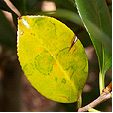 Camellia japonica
Camellia japonica 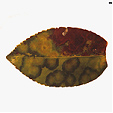
Palm Ring Spot (Bipolaris incurvate) has distinct brownish spots that are surrounded by yellowish rings. Heavy infection turns the leaves yellow causing them to die.
Palm Ring Spot (roystonea palm potyvirus) forms ring spots that become necrotic or chlorotic spotting on the new growth. Affected plants become stunted and die prematurely. Affected plants include; Roystonea and Chamaedorea species.
Source and Dispersal
The virus is derived from other infected plants or dispersed by sap sucking insects such as aphids or leaf hoppers. Corms, bulbs or tubers are commonly infected and the virus is spread by propagation material. These viruses are found from tropical to temperate climates.
Favoured Conditions
The viruses varies as some occur with out any documented favoured conditions, but certain viruses such as the Palm Ring Spot are more prevalent in hot wet conditions, especially when the plants are growing close together.
Affected Plants
Many plants are infected by Ringspots including; Camellia Japonica, Cichorium intybus , Howea and other palm species and perennials.
Carica papaya (Pawpaw) is infected by the Papaya Ring Spot which causes blemishes on fruit and leaves.
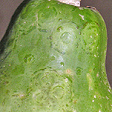 Pawpaw fruit
Pawpaw fruit
Delphinium species are infected by the Ringspot (Annulus delphinii) which causes chlorotic spots that may be encircled by yellow rings.
Gladiolus species are infected by the Tobacco Ringspot Virus (Annulus tabaci). It attacks the foliage and flowers causing stunting and fading of colours.
Non-chemical Control
Plants cannot be cured of this disease and it is important to maintain healthy mother stock for propagation by isolating it from infected stock. Infected leaves and plants should be removed and destroyed. When planting allow adequate spacing to allow good air circulation to reduce humidity and avoid handling the plants. All tools should be sterilised to minimise transferring infections.
Chemical Control
There is no chemical control for viral diseases but the use of the appropriate chemical control of sap sucking insects, such as aphids is advised.
Note
Always read the label for registration details and direction of use prior to application of any chemicals.
DISEASE
NAME
Root Knot & Other Nematodes
Meloidogyne & other species
Description
Root Knot Nematode or eelworms are transparent thin nematodes that are an organism up to 0.5mm long and attacks the roots by injecting saliva that stimulates the surrounding cells to form galls. The adult male lives in the soil and the female are found in the roots, laying up to 2,000 eggs in a mass in the soil adjoining the roots.
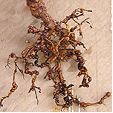
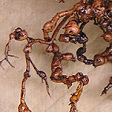
Symptoms
Above ground the plant infected by Root Knot Nematode develops slowly and is stunted. During hot weather the plant wilts easily as it is unable to keep up with the transpiration rate and under extreme conditions the plant dies. The young nematodes attack the roots forcing there way up the root tips forming galls. On inspection the galls are found centrally located along the roots and are up to 20mm across. The galls slow the rate of nutrients and water passing through the plant and as the galls break down they allow opportunity for other diseases to enter the plant.
The roots are severely damaged if the galls are physically removed.
Other species of nematode have simular symptoms and are individually discussed below.
Source and Dispersal
The nematodes are found in soil or in infested plants and are dispersed by water, soil movement and attached to tools or shoes.
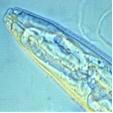 Nema Head
Nema Head
Favoured Conditions
It prefers sandy soil types and a warm moist weather conditions.
Life Cycle
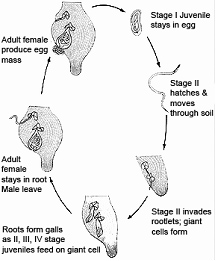
Affected Plants
A wide range of plants are attacked by the Root Knot Nematode including tomatoes, potatoes, carrots, tobacco, hibiscus, gardenia and roses. Some species of nematodes are plant specific such as (Meliodogyne incognita) which attacks Hemerocallis, Celosia and Viola species, forming small wart-like swelling on the roots.
Alternanthera, Begonia, Dianthus, Psidium, Thunbergia and Weigela species are attacked by the Root Nematode (Meloidogyne incognita). This forms small swellings on the roots causing the top growth to be stunted and not responding to improved culture. In cool climates it is found on plants in glasshouses.
Buxus species are attacked by the Meadow Nematode (Pratylenchus species) that turn the leaves a bronze colour and cause stunting of the plant. These microscopic nematodes enters through the roots and eventually result in the death of the plant.
Lagunaria patersonii is attacked by a simular nematode, the Root Burrowing Nematode (Radopholus similis) that feeds by burrowing in the outer root tissue.
Lavandula species that are grown in the northern United States are susceptible to the Peanut Root Knot Nematode (Melioidogyne hapla). Berberis species are also susceptible.
Tulipa species are attacked by Bulb and Stem Nematode (Ditylenchus dipsaci) which forms brownish streaks along the stem that may blister and may cause wilting. The flowers petals become distorted and the general vigour of the plant poor.
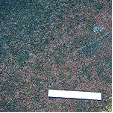
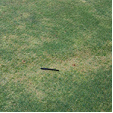 Nematodes damage
Nematodes damage
Turf Grass are susceptible to several Parasitic Nematodes including (Helicotylenchus species), (Xiphenema Species), (Hemicycliophora species) and (Ibipora lolii). All turf grasses are susceptible and the nematodes are active from spring to autumn requiring a soil temperature 15 ºc. The leaves become chlorotic and have a weak appearance as a result of the damaged roots. Generally it is only a major problem when the nematode numbers are very high, otherwise control is not warranted.
Cultural Control
Crop rotation in infected soils, avoid using plants from the Brassicaceae family for up to four years and plant species that are tolerant of nematodes, this will reduce numbers. Beds may be laid fallow for several seasons to deter nematodes, but numbers build up quickly once susceptible plants return.
Affected plants such as roses may have the bare roots dipped in hot water 45ºC for 15 minutes during the dormant period and contaminated growing media can be heat treated at 60ºC for 30 minutes before being used.
Any infested plants should be removed and destroyed or deposed off site.
Improve the soil structure and avoid acidity by the addition of lime or dolomite. Garden beds may also be pre planted with marigolds or mustard to deter nematodes, but should be removed or thoroughly composted prior to planting as they can push nematodes towards the crop. Green manure crops may be grown prior to planting and infested soil may require up to three seasons of manure crops to bring nematodes under control.
Biological Control
The encouragement of earthworms reduces nematode numbers as they accidentally eat them in there normal course of growth.
Chemical Control
The soil can be treated with a nematicide such as fenamiphos in a domestic situation. Commercial growers may fumigate the soil prior to planting with the appropriate chemicals.
Note
Always read the label for registration details and direction of use prior to application of any chemicals.
DISEASE
NAME
Grey Mould
Botrytis cinerea, B. elliptica
Description
Grey Mold, Shoot Blight, Petal Blight is a fungus problem that generally forms water-soaked spots that rot and produces greyish sclerotia (fungal resting bodies) on the surface. They can be found throughout the year on dead tissue and on live material during under ideal climatic conditions. Damaged areas such as a tear in a leaf or an opening made by an insect are more likely to be infected.
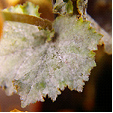 Grey Mold on Begonia species
Grey Mold on Begonia species
Image by B. Sonsie
Symptoms
The fungus attacks stems, leaves, flowers and fruit. In roses the fungus is primarily attacks the flowers producing pink rings on the petals and buds that become brown and rotten. This may extend down the peduncle to the stems causing dieback.
In other plants oval yellowish to brown spots appear, then the centre turns greyish and dries out and in humid weather the spots spread, joining up and infecting the entire leaf. This infection may also occur on the stems, and flowers may form abnormally or brown off and die.
When lettuce is infected it starts at the base causing a soft brown rot that may extend up the stem killing the plant, and pears flowers become infected then spreading to the fruit. This develops a sunken brown area that is soft and eventually is covered in grey powdery spores.
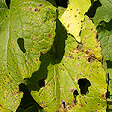
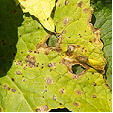 Botrytis Blight on Senecio cruentus
Botrytis Blight on Senecio cruentus
Botrytis Blight (Botrytis tulipae) infects leaves, flowers and stems with flecks of brown spots that merge to form light grey rotted areas that have brownish margin that may destroy stems. Affected areas are covered in a grey mould during humid conditions. The spores overwinter in dark brown sclerotia, which are found on the outer scales of the bulb or at the base of the stem in Tulipa species.
Grey Bulb Rot (Rhizoctonia tuliparum), which infects the bulbs of Tulipa species, attacking the base of the leaves and rotting the bulb. When bulbs emerge during spring in infected soil's they soon die off. The greyish mold tends to be dry.
Source and Dispersal
The sclerotia (fungal resting bodies) are found on dead plant material or in the soil and remain viable for many years. The spores are dispersed by wind or splashing water.
Favoured Conditions
It prefers cool moist climate with morning dew.
Affected Plants
Grey Mold attacks a wide range of plants including roses, fruit trees, pelargonium, ferns, grapes and cyclamens. Heliotropium , Amaryllis, Lilium and Hippeastrum species are also infected.
Agave species are infected by two fungal Leaf Blights (Botrytis cinerea) and (Stagonospora gigantea) that severely damage the leaves particular during wet periods or from excessive watering.
Cactus species are infected by soft rot or Grey Mould (Botrytis cinerea). Stems and pads turn are greyish with the upper surface, rotting then collapsing. The dieing tissue becomes slimy and is covered with grey mould that develops black sclerotia, which propagates the disease. It is more prevalent under warm humid conditions and control methods include removing infected parts and destroying them. In glasshouse situations ventilation should be improved and watering should be restricted to create a drier atmosphere.
Cereus species and other cacti are infected by Grey Mold causing the segments to become discoloured and as the rot progresses it tissue becomes slimy and collapses. Black sclerotia forms on the affected areas that are covered in grey mold during humid conditions.
Cuphea species are infected by this blight.
Orchids such as Cattleya, Cymbidium, Cypripedium, Dendrobium, Epidendrum, Oncidium, Paphiopedilum, Phalaenopsis and Zygopetalum species are infected by Grey Mold or Petal Spot (Botrytis cinerea). Petal and flower stalks form small brown spots.
Paeonia species are infected by Botrytis Blight (Botrytis paeoniae) causing the leaves and flowers to form a grey mold then suddenly collapse and die.
Pseudotsuga menziesii Douglas Fir is infected by Leaf and Twig Blight (Botrytis cinerea). This is a serious problem in wet conditions and is difficult to control.
Ribes species are attacked by Cain Blight (Botryosphaeria dothidea). The infection causes the cains to become blighted and wilt. To control remove damaged wood and destroy.
Non-chemical Control
Remove and destroy infected plants or fallen leaves. When planting, space as to allow good air movement to reduce humidity. Bulbs that are infected should be discarded and take care that bulb scales are removed from the soil to prevent further infection. Cactus and succulents that are infected should have the damaged areas cut out, or discard the entire plant. Under glasshouse conditions improve the ventilation and reduce watering to create a drier atmosphere.
Chemical Control
Under humid conditions spray regularly using a suitable fungicide such as thiram, mancozeb, dichloran and chlorothalonil.
Note
Always read the label for registration details and direction of use prior to application of any chemicals.
DISEASE
NAME
Fungi (General)
Various Fungal species
Description
A fungus is a plant that lacks chlorophyll and conductive tissue. Generally they are made up of branched threads called 'hyphae' and collectively form a vegetative body called 'mycelium'. The fungus is small but the fruiting bodies can become very large up to 600mm across such as bracket fungi or mushrooms. Common fungi are mould and mildews. problem that attacks the roots causing them to rot.
Fungus can reproduce many ways but primarily it is asexually, simular to cuttings of a plant and often occurs with minute portions of the mycelium (spores) separating. The spores can be arranged in a structure such as a sporangia or pycnidia or develop without an enclosed structure called a "conidia". Either way the fungus propagates very rapidly. Sexually reproduction occurs when two nuclei unite and form sexual fruiting bodies (zygospore).
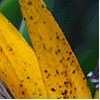 Strelitzia reginae flower
Strelitzia reginae flower
Symptoms
Fungus attacks all the above or below ground level parts of the plant living within the tissue of the plant and are very small and not normally detected until the fruiting body appears. However parasitic types such as powdery mildew or rust are visible on the outer surface of the plant.
Fungi hyphae may be divided by cross walls and known as "septate" while others with no cross walls are known as "nonseptate". These are the fungi responsible for cell leakage as in rot.
Back Mold (Chalariopsis thielavioides) affects understocks of grafted Rosa species by inhibiting the development of callus. It is whitish-grey maturing to black and can be found in the pith of the rose stem.
Black Root Rot (Chalara elegans).This recently introduced fungal disease in Australia (1993) affect plants by blackening the root systems and turning leaves yellow or purple. It is difficult to identify specifically as other pathogenic root diseases and nutritional deficiencies have simular characteristics.
The asexual spores are dispersed by wind or water. It is also transmitted on insects and in contaminated growing media or plants preferring humid moist conditions.
This fungus affects a wide range of ornamental plants including; annuals, perennials and shrubs. Examples are Begonia, Boronia, Camellia, Cyclamen, Fuchsia, Gerbera, Grevillea, Impatiens, Pansy, Petunia, Rosa species and Snapdragon.
Black Stem Rot (Pythium splendens) normally is a rot that occurs in cuttings turning the stem progressively black and shrunken. The leaves fall and the plant becomes stunted, eventually dieing.
Bleeding Necrosis (Botyosphaeria ribis) attacks and kills the inner wood causing the bark to split open and bleed sap giving it an oily appearance.
Blight (Endothia parasitica) is a serious pest of Castanea species, entering the twigs and small branches, and then progressively travelling throughout the tree killing it. It may form cankers on the base of the trunk or in the dead branches above with the amber coloured fruiting bodies pushing there way through the bark.
Copper Web ((Rhizoctonia crocorum). This fungal disease appears in defined patches causing the corms in the centre to become a black powdery mass. Corms on the outer ring of the patch that are partially infected forming a felty mass of violet threads on the corm scales. These threads extend into the soil and large sclerotia forms in the soil and on the corms. Healthy corms become infected from contaminated soil that contains mycelium and sclerotia.
Dry Rot (Phyllosticta concave) forms small circular spots that increase to a diameter of 30mm, and then becomes sunken as the cells collapse. The infected area develops minute black fruiting bodies.
Dutch Elm Disease (Ceratocystis ulmi) is a serious fungal problem of Ulmus species that initially causes yellowing then wilting of the leaves that turn brown and die. This may be seen on certain branches of the tree and on inspection under the bark the sapwood reveals brown streaks. A cross section of the affected branch displays round spots that are dark brown. This infection normally spreads quickly throughout, killing the tree in one to two seasons.
Dieback in Camellia (Glomerella cingulate) is a pathogenic fungus that infecting existing wounds such as leaf scars or mechanical damage, forming a sunken area (canker) that spreads around the stem causing die back. The affected plant has new shoots that are brown-black and the tips curl, forming a 'Shepard's Crook' appearance. The leaves also die but are persistent on the plant and the spores are found in soil or on other infected plants.
Curvularia Leaf Spot (Curvularia species) in Turf Grass. This is normally a secondary weak fungal infection that forms spots on the leaves that lengthens turning the leaves greyish. The leaf shrivels then dies and infected areas appear as weak patches in the turf. Preventive measures include minimising leaf wetness and excessive use of nitrogen fertiliser.
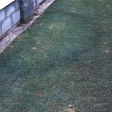 Fairy Rings Blue Couch
Fairy Rings Blue Couch 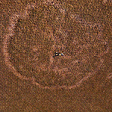
Fairy Rings are a fungal problem in Turf Grass and is caused by several species including (Lycoperdon species), (Marasmius species) and (Tricholoma species). Rings appear in the turf as fruiting bodies or dead grass and as lush green foliage. The mycelia expand radially in the turf feeding on soil nutrients and organic matter with water present.
Under severs conditions the mycelia consume all available nutrients resulting in the death of the turf. Lush turf can result from a less developed infection, where the decomposing hyphal releases nitrogen. This available nitrogen may be beneficial to the turf but some forms of nitrogen are detrimental.
Leaf Blister (Taphrina coerulescens) appears as yellowish circular raised areas on the upper side and depressions on the underside of leaves, up to 15mm across. As the fungus spreads the leaf dies but remains attached to the tree and this infection is commonly found on Quercus species..
Leaf Blotch (Guignardia aesculi) forms small or large water soaked spots that are reddish with a bright yellow margin and form black fruiting bodies in the centre. The affected leaf and petiole have a scorched appearance before falling, found on Aesculus species
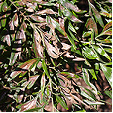 Grevillea robusta
Grevillea robusta 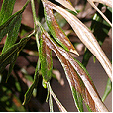 Leaf Scorch
Leaf Scorch
Leaf Scorch (Verrucispora proteacearum) is a fungal disease that infects leaves causing large parts of the leaf to turn grey-brown, giving the appearance that it has been singed by fire. Black fruiting bodies appear on the affected areas and the leaf soon withers then dies. New, mature leaves are affected during very wet periods towards the end of the branches and Grevillea and Hakea species are susceptible.
Melting Out (Helminthosporium vegans) forms bluish black spots with straw coloured centres on the leaves and may be found on the sheath, encircling it causing Foot Rot. It infects grasses particularly Poa pratensis. There is another fungus that is simular Helminthosporium Blight (Helminthosporium dictyoides) that infects Poa, Festuca and Agrostis species.
Pad decay (Aspergilus alliaceus) infects Cereus and Opuntia species and occurs at during periods of high temperature. The yellow spores at the epidermal layer through wounds and germinate on mass causing the area to become soft and spongy. An anthracnose called Shot Hole is a similar forming brownish spots the turn grey, and then black destroying pads. Control methods include physically removing damaged pads and allowing the Sun to heal wounds.
Potato Gangrene (Phoma foveate) is a soil borne fungus that infects the roots during harvest primarly through wounds and develops during storage. The potatoes rot from the inside forming rounded depressions on the surface and have a strong odour of rotten fish.
Root Rot Fungi (Phymatotrichum omnivorum) and (Pellicularia filamentosa) cause the roots to rot and the plant suddenly wilts then dies.
Root Rot (Pythium debaryanum) forms water soaked dark brown streaks that affect all parts of the plant causing wilting then dieing. It infects Ranunculus species, it also infects cactus species by forming brown spotting and wilting that appears at the base of the plant then extends towards the top. It quickly spreads from plant to plant in collections and is controlled by avoiding over watering, excessive humidity and are using a sterilised soil when potting up.
This fungus also is responsible for damping off of seedlings in a glasshouse environment.
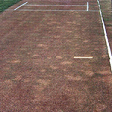 Spring Dead Spot
Spring Dead Spot 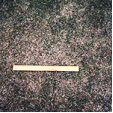
Spring Dead Spot (Leptosphaeri species) is a fungal disease that infects Couch Grass. It first appears during autumn as pale bleaches areas up to 500mm (20in) wide and persists throughout winter. In spring the affected areas do not recover or recover slowly and on inspection the roots or rhizomes are rotted. Runners from the surrounding healthy turf will help with recovery and all signs of the problem disappear by mid summer.
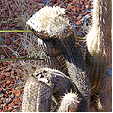 Cactus species
Cactus species 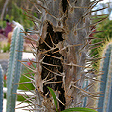 Pachypodium species
Pachypodium species
Stem Rot (Helminthosporium cactivorum) forms well defined yellow lesions that mature into soft dark brown rot. It commonly infects Cactus species entering through the stomates or wounds. Heavily infected plants collapse and die.
Stem Rot or Basal Rot (Pellicularia rolfsii) is a soil borne fungus that infects the stem root junction and extends into the leaves. In orchids the leaves become discoloured, dry and detach from the base which is covered in a fungal growth that produces sclerotia. The sclerotia is whitish to yellow then becoming dark brown and can be viable for up to four years.
White Mold (Ramularia desta f. odorati) occurs on both sides of the leaf and looks simular to powdery mildew but forms faint dull, reddish brown elongated spots on the leaf that may be depressed or along the margin where they have a watery appearance. Tufts of hyphae develop in the stomates.
Wilt (Ceratocystis fagacearum) causes leaves to curl then turn brown and the sap wood may also turn brown or black. Heavy infection may kill a tree within two seasons and is found on Quercus species and other ornamental trees.
Witches Broom may be a fungal problem that causes a proliferation of small axillary shoots to appear at the end of the branches. Little is known about this problem, though it affects a wide range of plants including Eucalyptus, Leptospermum and Pinus species.
Source and Dispersal
Fungus is found in the soil or on other infected plants and after releasing the spores, they are dispersed by wind or are transmitted in infected stock, insects and with splashing water.
Wilt is transmitted by infected root stocks, several species of insect and contaminated tools.
Dutch Elm Disease is transmitted by bark beetles such as (Scolytus multistriatus) and (Hylurgopinus rufipes). These beetles deposit eggs in the sapwood where the lava tunnel and pupate. The emerging beetles tunnel the bark and carry the fungus to fresh feeding sites on the tree. Infected beetles may also be transported to fresh sites in waist material.
Favoured Conditions
Prefers cool moist conditions with temperatures from 10º to 25ºC and is more common from autumn to spring when it is wet.
Affected Plants
A wide range of plants and all parts can be infected by various fungal diseases. Bleeding Necrosis is found in Liquidambar species and Stem Rot or Dry Rot infects Cactus species such as Opuntia and Pelargonium.
Abies species are infected by several fungi that cause Leaf Cast which turn the needles yellow to brown then fall prematurely.
Abutilon species are infected by the Stem Rot (Macrophomina phaseolin) affecting the lower stems and is not commonly seen.
Achillea, Cuphea, Leucanthemum, Euphorbia species are infected by the Stem Rot (Pellicularia filamentosa) which enters through the roots and rots the base of the stem.
Alternanthera species are infected by the Leaf Blight (Phyllosticta amaranthi) which forms small brown spots on the leaves causing them to curl and die.
Aloe, Astrophytum, Copiapoa, Echinocactus, Espostoa, Ferocactus, Gymnocalycium, Kalanchoe and Schlumbergerera species are infected by Bipolaris Stem Rot (Bipolaris cactivora). This infection affects many cacti species causing rot in the stems with a blackish appearance.
Amelanchler is affected by the Witches Broom (Apiosporina collinsii).
Antirrhinum species are infected by the Blight (Phyllosticta antirrhini) that forms light brown spots on the upper-side of the leaf and on the stem. As the spots enlarge they turn greyish with black fruiting bodies in the centre, then become brown and killing the affected areas.
Begonia species are infected by the Stem Rot (Pythium ultimum) turning stems black then becoming soft and causing the plant to collapse. This is the same fungus that causes Damping-off.
Betula species are affected by the Leaf Blister (Taphrina bacteriosperma) which curls the leaves and forms reddish blisters.
Chamaedorea and other cain-like species are infected with Gliocladium Stem Rot (Gliocladium vermoseni) which forms a dark basil stem rot generally on damaged plants and produces orange-pink spores. The mature leaves are first affected and eventually the stems or cains rot and die.
Crocus and Gladiolus species are infected by the Dry Rot (Stromatinia gladioli), which causes lesions on the corms and rots the leaf sheath.
Crocus, Iris, Tulipa, and Narcissus species are infected Copper Web ((Rhizoctonia crocorum).
Dianthus species are infected by Phialophora Wilt (Phialophora cinerescens) that causes the leaves to fade and plants to wilt. There is obvious vascular discoloration which is very dark. It is not found in Australia.
Erythrina x sykesii may be infected by the Root Rot Fungi (Phymatotrichum omnivorum).
Fern species are infected by Tip Blight (Phyllosticta pteridis). This blight produces ash-grey spots with purple brown margins and the fruiting bodies appear as black pimple like spots. It is transmitted by air or moisture and in infected fronds become brown and die. Control methods include sprang fungicide on leaves or reducing humidity and avoid wetting the fronds.
Forsythia species are infected by Stem Gall (Phomopsis species). It forms rounded growths along the stems causing them to die and look unsightly.
Gladiolus species are infected by Penicillium Rot of Corms (Penicillium gladioli). This disease forms deeply sunken reddish brown areas that become corky and produce a greenish fungal growth.
Hedera species are susceptible to several Fungal Leaf Spots including (Glomerella cingulate), (Phyllosticta concentrica) and (Ramularia hedericola). All of which cause yellowish spots that develop into dry brown blotches that kill the leaf.
Larix species are susceptible to Leaf Cast (Hypodermella laricis). This fungus attacks the needles and spur shoots turning them yellow at first then brown after which small black fruiting bodies appear on the leaves during winter.
There are several other fungi including (Cladosporium species) and (Lophodermium laricis) cause leaf blight or leaf casts.
Orchids such as Cattleya, Cymbidium, Cypripedium, Dendrobium, Epidendrum, Oncidium, Paphiopedilum, Phalaenopsis and Zygopetalum species are infected by Phomopsis Rot (Phomopsis species). This fungal problem forms a firm brown rot that appears on the leaves, pseudobulbs and rhizomes. The affected areas have yellow margins and the centre is covered in tiny black specks (fruiting bodies). Cattleya species are particularly susceptible. These plants are also infected by Psudobulb Rot (Mycolleptodiscus coloratus implicated). Dark spots appear on the pseudobulbs eventually causing extensive rot and killing the bulb.
Palms are infected by the fungus Butt Rot (Ganoderma sulcatum). The fungus entered the lower trunk normally as a result of mechanical damage (lawn mower). Symptoms include stunting of new growth and yellowing of the lower leaves. Fruiting bodies become evident at the base of the trunk. There is no effective control method and replanting in infected soil should be avoided.
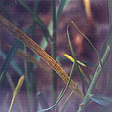 Kikuyu Yellows
Kikuyu Yellows 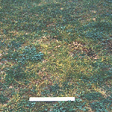
Pennisetum clandestinum (Kikuyu) is susceptible to Kikuyu Yellows (Verrucalvus flavofaciens), thisis a water mould that infects the roots and causes them to rot. The infection extends up the stem and onto the leaves with yellow discolouration and can be limited to a small or large area up to 1m (3ft) wide.
It is found in warm temperate to sub tropical regions and dispersed in infected soil or plant material. There is no chemical control, nitrogen fertiliser masks the symptoms and complete fertiliser encourages stronger roots to fight the disease.
Pittosporum, Antirrhinum, Aquilegia, Echinops and Orchid species are infected by the Stem Rot or Basal Rot (Pellicularia rolfsii) commonly in the northern hemisphere and preferring humid glasshouse conditions.
Solidago species are infected by the fungal Scab (Elsinoe solidaginis) which covers the leaves and stunts the growth of the plant. Young plants may be killed.
Trillium species are infected by the stem rot (Pellicularia rolfsii) and ( Ciborinia trillii). This normally occurs in wet soils and is detrimental to the plants life.
Tsuga species are infected by Sapwood Rot or Butt Rot (Ganoderma lucidum) and (Coniophora puteana), which attacks the sapwood close to the bark, towards the base of the tree. Commonly killing the host.
Tulipa species are affected Blue Mold (Penicillium species) and the fungus (Rhizopus stolonifer) causing rot in the bulbs.
Vinca species are infected by the soil born Root Rot (Pellicularia filamentosa) which rots the stems and roots.
Viola species may be infected with the Scab (Sphaceloma violae) which attacks all parts of the plant including the seed capsule forming yellowish spots that turn brown and in leaves fall out. Stems and petioles can be girdled killing the upper part.
Viola species are also infected with the Stem Rot (Myrothecium roridum) which attacks the stems at ground level causing them to become dry and brittle. The leaves show symptoms by turning purplish-black and this fungus also infects Alcea and Antirrhinum species.
Non-chemical Control
Generally remove and destroy any infected plants or plant parts, when replanting, avoid using susceptible species for 3 years. When growing crops space the plants to reduce the humidity and airflow and cultivate the soil to increase the drainage. Remove weed growth from around the susceptible plants.
Avoid over watering the surrounding soil which encourages fungal development. In the case of trees remove any infected branches and heavily infected trees should be cut down and removed. This infected material should be disposed or burnt. Damaged trees should have the wounds dressed and sealed as a preventative measure particularly for Dieback in Camellia.
Deter Potato Gangrene by planting clean stock and be careful not to damage the crop when weeding. When harvesting the tubers choose a dryer period and be careful not to damage them.
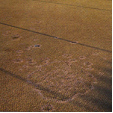
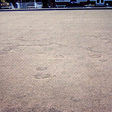 Fairy Rings
Fairy Rings
Fairy Rings in Turf are difficult to control and may appear or disappear sporadically. Cultural practice such as minimal thatch build-up, regular aeration and a reduction of organic matter spread on the turf will reduce infection.
Chemical Control
No suitable fungicides available, though drenching or spraying the soil with the fungicide dichloran helps control soil born fungi.
Note
Always read the label for registration details and direction of use prior to application of any chemicals.
Average Lowest Temperature : -5º C 23º F
USDA : 7, 8, 9, 10
This USDA (United States Department of Agriculture) hardiness zone chart can be used to indicate a plant’s ability to withstand average minimum temperatures. However, other factors such as soil type, pH, and moisture, drainage, humidity and exposure to sun and wind will also have a direct effect on your plant’s survival. Use this chart only as a guide, always keep the other factors in mind when deciding where, when and what to plant.
A plant's individual USDA zone can be found in the Plant Overview.
Climate Description
Cool Temperate
This zone has low winter temperatures and moderate summer temperatures with low humidity and cool nights. Frosts are severe with snow at higher altitudes.
Drought rarely occurs and wind is cold inland or wet on the coast.
Plant growth
Cool weather plants grow well.
| Dictionary | Growth Habit |
| Leaf Type | Botanic Flower Description |
| Leaf Shape | Flower Inflorescence |
| Leaf Arrangement | Fruit Type |
| Leaf Margin | Bark Type |
| Leaf Apex And Bases | Flower Description |